Portugal – attractions, map, sightseeing plan, trips, the most beautiful places
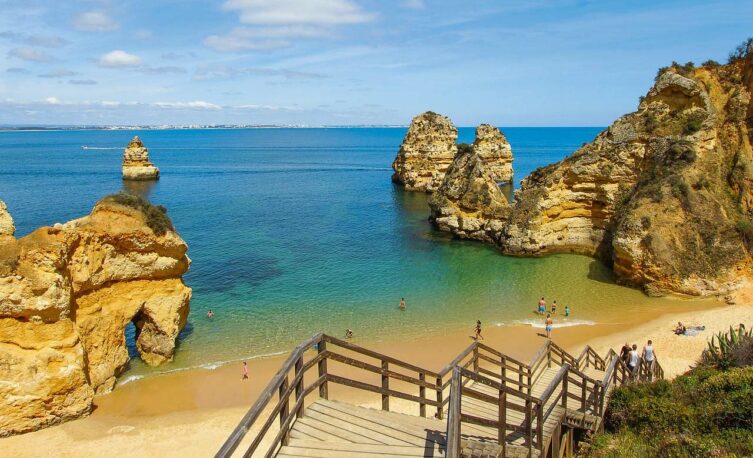
Does anyone need encouragement?
I don't think anyone should be encouraged to visit Portugal. A country located at the end of Europe, with a long and colorful history, rich culture, great food, beautiful nature and countless fantastic monuments... a country offering all this is a natural destination for every travel enthusiast. As if that wasn't enough, Portugal's location means that it is not overly crowded with tourists. Of course, there are places where it can be really dense (or even very dense). However, there are many more places that can be visited from a pleasant comfort zone.
Someone will ask: what about prices? What are the prices in Portugal? Exactly! I saved the best for last. Prices in Portugal certainly won't break your wallet. It is cheaper here than in most European countries. If you have a holiday in Croatia, Italy, Madeira, Mallorca or Spain within your reach, Portugal will pleasantly surprise you.
We're going to Portugal
Only the Spanish are close to Portugal. The rest of Europe has to travel quite a long way and usually does it by plane. The main air traffic is served by three cities: Lisbon, Porto and Faro. Airline prices vary and are strongly related to the tourist season. They definitely increase during the holidays, but outside the summer season they can be really attractive.
Portugal has plenty of air connections to most major cities across Europe. For example, from Poland you can fly here without transfers from four cities: Warsaw, Krakow, Wrocław and Poznań.
Writing this text (end of August 2023) I checked the September and October flight prices from Poland to Portugal:
- do Lisbon we will arrive in 84 - 114 EUR
- do Oporto we will arrive in 78 - 103 EUR
- do Faro we will arrive in 76 - 96 EUR
There is no point in getting to Portugal by your own car. The distance from Warsaw to Lisbon is 3500 km. The one-way trip will take you three days. By covering 7000 kilometers round trip, you will waste half of your vacation and spend a lot of money unnecessarily on fuel and accommodation. You will arrive there, tired from the drive, and the sightseeing will only just begin. Traveling to Portugal by car is an absolutely terrible idea. I definitely recommend the plane.
In this situation, the question that becomes the title of the next chapter becomes natural.
How to visit Portugal?
The answer to the above question is trivial and simple. Basically, you have two sensible options to choose from: public transport or a rental car. Both are good, but neither of them is universal enough to work in every situation.
Public transport is good when you only intend to visit the area close to your place of stay. Lisbon is a good example here. You can treat it as your headquarters and visit the attractions located nearby (e.g. Sintra) by local transport (I described it in more detail in entry about Lisbon – [click]). Unfortunately, you won't be able to visit all of Portugal this way. Theoretically, it's possible, but it wouldn't even take your entire vacation to do it. If you are going to Portugal without renting a car, limit your appetite for sightseeing. Plan only the largest towns and, possibly, the immediate surroundings that are well connected to them. More than half of what could be seen will be beyond your reach.
However, before you choose this option, I encourage you to read the next paragraph related to renting a car.
Car rental that's definitely it my preferred way to explore Portugal. This is supported not only by convenience, but also by saving time, efficiency of movement and enormous freedom to shape your own plan. During such trips, you sometimes have to change the plan at the last minute and do something differently. Having your own car does not limit you in any way and allows you to easily make the necessary changes. I'm leaving aside technical issues related to the selection of hotels. With a car at your disposal, you can stay wherever you want. A small hotel outside the city, surrounded by nature and silence, will be a pleasant place to relax. It will certainly also be much cheaper than staying overnight in a big city, close to transport hubs, which you will have to spend traveling with a suitcase on your feet.
You can analyze this in even more detail and count how many people travel by train is more expensive than traveling by car (on the train, each person has to pay for a ticket separately, and traveling by car always costs the same, regardless of whether there are one or four people traveling), but it's a pity time for this. Instead, we will see what the actual cost of renting a car in Portugal will be.
Renting a car in Portugal – a simple explanation of complicated matters
Many people are afraid to rent a car. I understand that! I had the same experience. However, quite a few years ago, I decided to delve deeper into the topic and then try it out for myself. It turned out that the devil was not so scary! Everything went well, and the entire expedition benefited greatly, giving us access to previously unattainable attractions. I quickly became a passionate supporter of sightseeing in a rented car and now I have rented so many cars in various rental companies and countries that I have stopped counting. Back then, I didn't know that one day I would write a blog, but over time it turned out that the knowledge and experience I had collected could be useful to others. I sat down and wrote several guides, trying to explain the intricacies of renting a car in a simple way. I managed to develop a simple, clear and clear procedure for renting a car, which allows you to rent a car avoiding threats, pitfalls and mishaps.
Portugal has its own guide on this subject and I encourage you to read it in a separate entry: Portugal – how to safely rent a car [click]. I guarantee that after reading it, the matter of renting a car will become really simple for you and will no longer raise such concerns.
In this entry, I will only deal with a simple comparison of car rental prices, found in accordance with the principles described in the guide. Here, we only want to find out the actual costs of renting a car.
True to form, I will look for safe offers, with full insurance, no credit card and no deposit. So we smoke full luxury!
So let's check what the cost of renting a car will be for: 1 week, 2 weeks and 3 weeks. I chose Lisbon airport as the place to pick up the car.
I will search in the best (in my opinion) car rental comparison website Discover Cars - [click], comparing offers from over 200 rental companies. You can see the results of the search in the pictures below.
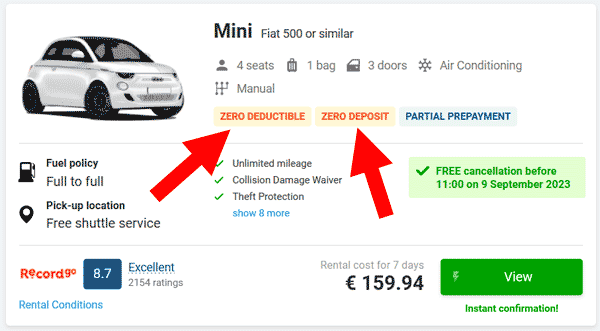


Let's summarize the result:
– car rental on one week between September 11-18, 2023 = cost 159 EUR
– car rental on two weeks between September 11-25, 2023 = cost: 295 EUR
– car rental on three weeks September 11 – October 2, 2023 = cost: 389 EUR
check out: compare car prices in Portugal – [click]
First of all, I bet you expected higher amounts. I would like to remind you that this is a fully insured rental. You do not bear your own risk for possible damage or theft, and you do not block any deposit on the card.
Cost per level EUR 20 per day is a great price. In most of Europe, the price for this type of rental is over EUR 40 per day. I don't think you can rent a car at this price even here in Poland :)
When renting for three weeks, the price drops to EUR 18 per day!
We start planning the trip
The guide you are reading will be constructed differently than all the guides you have ever read. Most guides are nothing more than a list of attractions and... that's it. Actually, not much comes of it. My goal is to give you a tool that will allow you to plan your own dream trip. Of course, I will propose some original, ready-made plans. However, I assume that after reading this, if you don't like my suggestions, you will be able to create your own, perfectly tailored plan.
So before we move on to the map with attractions, let's take a look at the size of Portugal. Look below at the map I prepared.
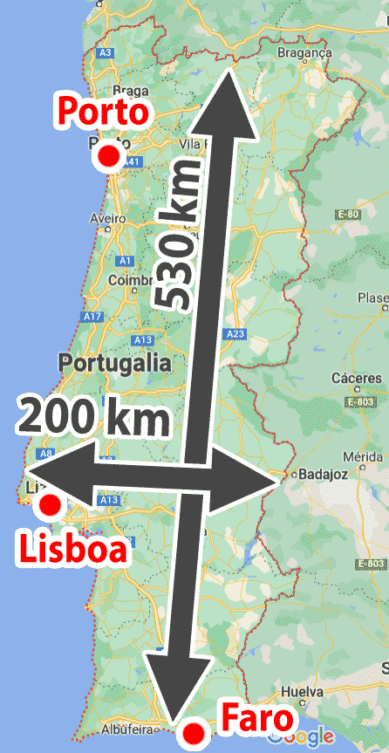
The map is simple but contains some key information. First of all, the dimensions of Portugal, i.e length 530 km i width 200 km they tell us that by dividing the tour into several or a dozen or so days, it can be traversed in relatively short sections, and you won't have to spend many long hours of the day in a car. What may seem like a disadvantage at first glance, i.e. the narrow and long shape, will work well in practice (but I will write about this later in the text).
Note the location of major airports. In my opinion, it couldn't be better. One is in the south, the second in the center and the third in the north of the country. This is good news, especially for those who cannot afford a long vacation and will spend no more than 7 days on sightseeing. In this situation, it is easy to divide the country into two halves. Visit the north and the center on one trip, and the south and the rest of the center on the second.
In order not to be too colorful, I will only add that the number of attractions worth seeing in Portugal cannot be accommodated even during a long, 2-week vacation. It is true that I will propose a two-week plan, but I warn anyone who wants to undertake it that it is extremely intense. There is not a single lazy day in it. Every day is filled to the brim. To see everything at a leisurely pace and have a day to rest from time to time, you need at least three weeks. For this reason, when analyzing the costs of renting a car, I also provided the version for three weeks of rental.
It is clear to me that not many people will be able to spend three weeks here, but if someone finds the time and resources, I encourage them. I am convinced that this will be one of the best-mentioned trips of all time.
Accommodation in Portugal
Portugal has great accommodation facilities. My trip will also lead through very interesting but less obvious, isolated and less accessible attractions. Naturally, in these places the choice of accommodation will be smaller, or you will have to look for accommodation somewhere nearby. I will include helpful links next to the attraction descriptions to make your search easier. I prepare the links in such a way that: contain filters blocking offers that we are not interested in, e.g. from very distant places. It's worth starting your search with these links. They save a lot of time.
Portugal – map of tourist attractions
It's time for the most important map of this entry, i.e. the map of attractions in Portugal. It is my main tool when planning a trip and it will be your main tool too. It is worth spending some time getting to know it and checking the location of the places you are interested in. Clicking on the map will open a higher resolution image that you can enlarge.
There is also a map of Portugal available as a PDF file with the ability to zoom and quick links to descriptions and GPS coordinates. A version of the map that can be downloaded to your phone (and computer) can be found in a separate entry: Portugal - PDF tourist map. In addition to the map, the entry also contains a short instruction on its use.
If you plan your trip on your own, start by choosing the places that are most important to you and which you definitely do not want to miss. Then, depending on the time you have and the route outlined by the main attractions, add to the route what will be on its way and your plan is ready!
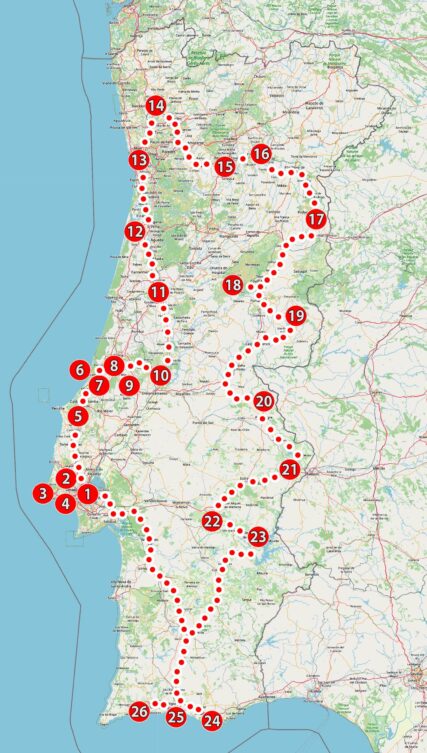
As you can easily see, each attraction marked on the map has its own number. In the further part of the text under this number you will find additional information related to a given attraction. It will be mainly a short description and some important information (if necessary).
Usually next to each attraction I put the GPS coordinates of the nearest car park and (if necessary) additional coordinates of key points that will help you get to the right place. Use this data!
They are very simple to use. Just click on the link next to them, and the navigation will start automatically and calculate the route to your destination (just don't forget to switch the navigation from pedestrian mode to car mode or vice versa).
Many of the attractions (e.g. Lisbon, Benagil Cave, etc.), in addition to the short description included in this plan, also have separate, more detailed studies. If such studies exist, you will find links to them in these descriptions. It is worth visiting them because they contain a huge amount of useful data, practical advice, additional photos, detailed situational maps, etc. I am gradually creating new entries, so there will be more links to extended descriptions.
Portugal sightseeing plan
I'll tell you right away: this plan is one of the top plans with the highest degree of intensity. There are plenty of UNESCO-listed sites, not to mention other attractions that are as good as those on the UNESCO list. Most people who want to do it will not be able to complete it in its entirety. So you ask why I prepared such a plan? The reason is simple and in a moment you will think that I cleverly invented it. I assumed that not everyone is interested in the same thing. Therefore, if the plan were not so dense, removing one attraction from it would create a hole. For me, throwing out what you are less interested in doesn't bother me at all, because there are several other suggestions right next to it. So you can go ahead and get rid of what you don't want and there will still be something to watch. Isn't it cunning?
The sightseeing plan follows the route shown on the map above showing the location of the attractions. I entered the route into Google Maps and checked its length.
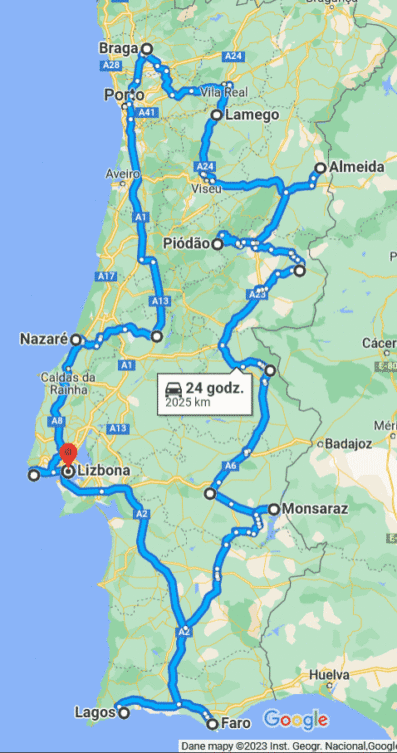
As you can see from the screenshot from Google Map above, the total length of the route is approx 2 000 km, and the travel time is a total of 24 hours (if you drive without a break). However, these numbers should not be treated as binding. In practice, you will definitely get more kilometers and more hours. It's safe to assume that you'll travel more than that in total 2 500 km, and you will spend on average approx 2,5 hours. Sometimes it will be more (such as on the way to Piodao i Monsanto), and sometimes less (like when sightseeing Lisbon or Porto, where you probably won't get into a car at all).
At first glance, the plan does not seem difficult at all, but its main burden is not the journeys, but the number and time-consuming nature of the planned attractions. So let's take a look at the whole trip in detail.
day 1 – Lisbon (1)
I set aside one day for Lisbon. It's really not enough. However, I don't leave you empty-handed and say: you have one day in Lisbon and deal with it yourself. Oh, no no! Of course, I prepared a plan to visit Lisbon in one day and shared it in a special Lisbon guide – [click].
If you decide to spend more time in Lisbon (1), in the same guide you will find ideas for a longer visit to the capital of Portugal.
day 2 – Sintra (2)
You need to spend one day on Sintra (2). It can't be done in less time. Sintra (and especially Pena Palace) is one of the most popular attractions in this part of Europe and it is almost always crowded. In the summer season, blinds can be assumed to be very crowded. So I suggest you go sightseeing really early in the morning and start at Pena Palace.
day 3 – Cascais (3), Estoril (4) and something for dessert
Transit route: Lisbon (1) – Cascais (3) – Cabo da Roca (3.1) – Queluz (3.2) – Lisbon (1)
Length of the ride: 100 km
Driving time (without breaks and sightseeing time): 2 h
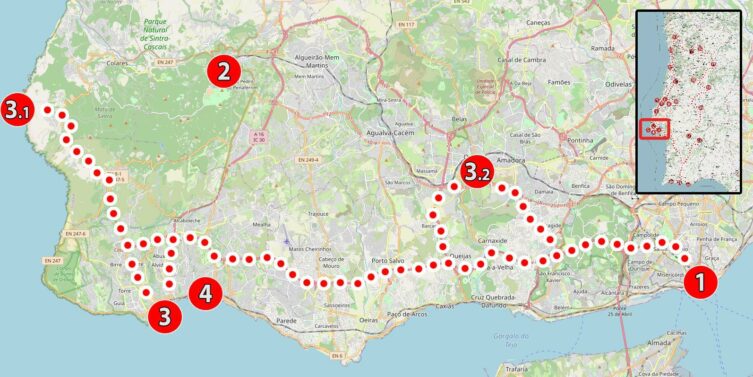
On the third day we will go to the coast of Portugal and catch some sea air. There will even be some time to sit on the beach for a while. We leave Lisbon and go to Cascais (3). We visit tiny Cascais (3), and then we go to the promenade running along the seashore and walk to Estoril (4). On the way, we admire the sea, rocks, yachts and coastal buildings. At the ramparts in Estoril (4) we turn around and return to the car in Cascais (3).
Then you have two options:
- first is a trip to Cabo da Roca (3.1), the westernmost land in continental Europe, with beautiful views of the rocky coast, and then a visit to the beautiful Royal Palace in Queluz (3.2)
- second it's a return to Lisbon (1) and seeing what we couldn't see on the first day. Along the way, you can also stop by the Royal Palace in Queluz (3.2).
day 4 – Obidos (5), Alcobaca (7), Nazare (6)
Transit route: Lisbon (1) – Obidos (5) – Alcobaca (7) – Nazare (6)
Length of the ride (without possible return to Obidos): 140 km
Driving time (without breaks and sightseeing time): 2 h
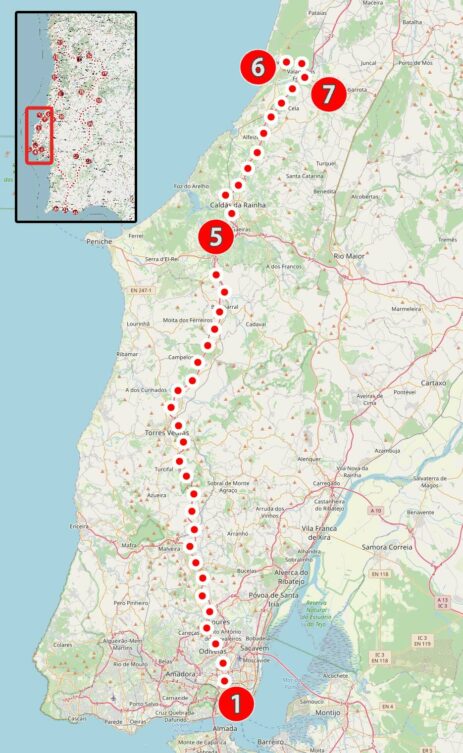
On the fourth day, we leave the Lisbon area and go to Obidos, a UNESCO site located 85 km away (5). The town is surrounded by a fully preserved original medieval defensive wall and has picturesque, narrow, cobbled streets. Along the streets there are houses painted in traditional white color, abundantly decorated with flowers.
From Obidos (5) we go to Alcobaca (7). The main attraction of the small and very pleasant town is the UNESCO-listed monastery (Mosteiro de Alcobaca).
The next point on the program is Nazare, located by the ocean and known for the world's largest waves (6). The probability that you will see giant waves in summer is slim, because they occur mainly in winter (November to February). Nazare is a good base for accommodation on this day. As a popular holiday resort, it offers a large selection of accommodation and diverse gastronomy.
Another tempting idea for an overnight stay is medieval Obidos, which looks really beautiful in the artificial evening lighting. Unfortunately, the return from Nazare to Obidos is an additional 40 km.
day 5 – Batalha (8), Fatima (9), Tomar (10)
Transit route: Nazare (6) – Batalha (8) – Fatima (9) – Tomar (10) – Coimbra (11)
Length of the ride: 160 km
Driving time (without breaks and sightseeing time): 2 h 30 min
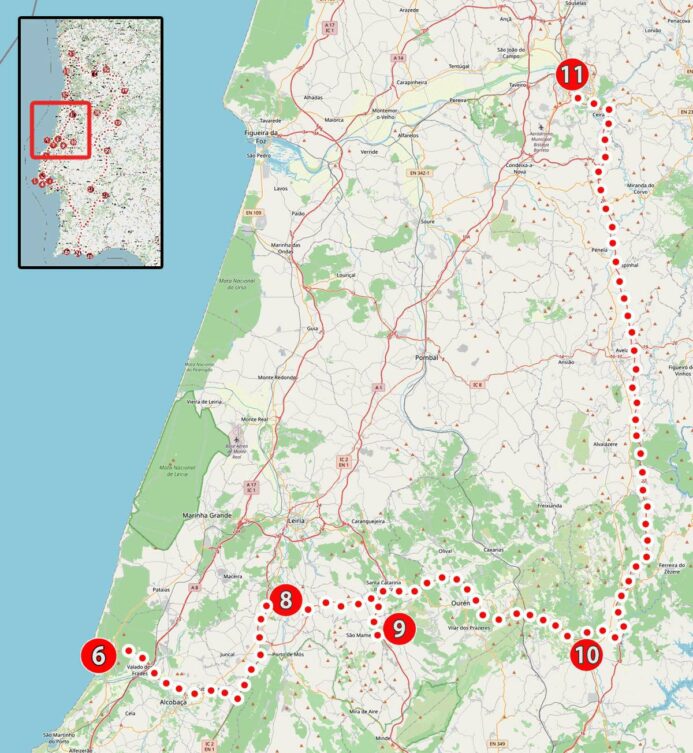
We will start the next day with a visit to the next UNESCO site. The monastery at Batalha (8) is stunning. I suggest you put it on your must-have list. The same is true of the Templar Monastery in Tomar (10) (also on the UNESCO list). I don't know how many times I have returned to the photos from these places and just remembering them gives me a pleasant thrill of memories. As for Fatima (9), it will certainly be very exciting for believers and those interested in events related to this place. In terms of architecture, Fatima is definitely worse compared to the other two facilities, but you don't come here for the architecture.
At the end of the day, I suggest going to Coimbra for the night (11). You will be able to feel the evening atmosphere of the city, sit somewhere where you can listen to live fado, and go sightseeing in the morning after breakfast.
day 6 – Coimbra (11), Aveiro (12)
Transit route: Coimbra (11) – Aveiro (12) – Porto (13)
Length of the ride: 142 km
Driving time (without breaks and sightseeing time): 1 h 45 min
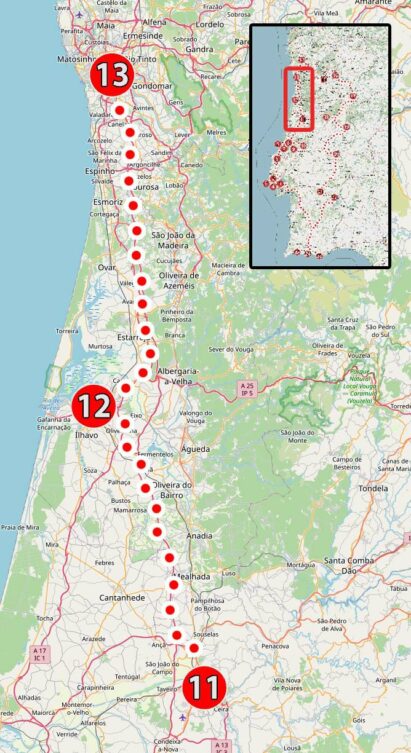
The sixth day in the morning is devoted to visiting Coimbra (11), including the University of Coimbra, which is on the UNESCO list. In the second part of the day we go to picturesque Aveiro (12).
Before the evening, I suggest going to Porto (13) and spending the night there, so that you have the whole next day to explore the city.
day 7 – Porto (13)
You need to spend the whole day and evening in Porto (the old city on the UNESCO list), so another overnight stay is also possible here. Needless to say, after one day in Porto you may feel a bit unsatisfied, but on the other hand you will definitely be able to see a lot. A solid sightseeing plan will definitely do a good job.
day 8 – Braga (14), Lamego (15)
Transit route: Porto (13) – Braga (14) – Lamego (15)
Ride length: 193 km
Driving time (without breaks and sightseeing time): 2 h 15 min
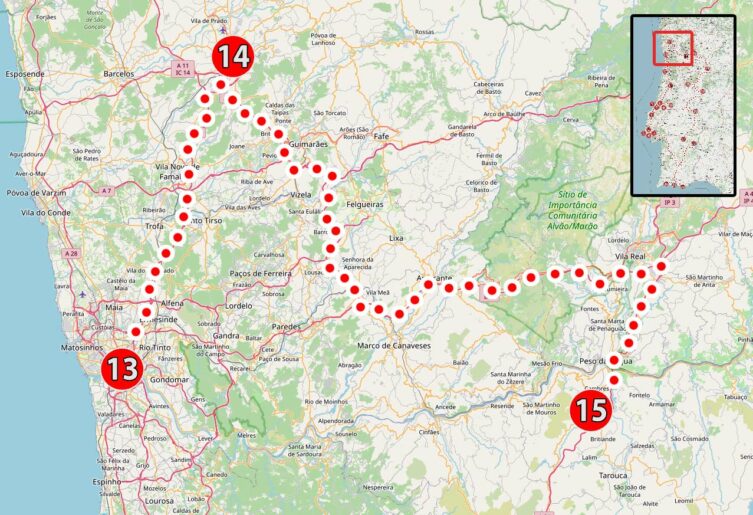
I recommend leaving Porto immediately after breakfast and without unnecessary delay. Today's plans include Braga (14), one of the oldest Christian cities in the world, and also one of the oldest cities in Portugal (Sanctuary of Bom Jesus do Monte in Braga on the UNESCO list).
Unfortunately, the plan does not include overnight stay in Braga and after visiting the city, we go to Lamego (15) located in the Douro Valley.
day 9 – Douro Valley (16)
We will spend the ninth day of the trip in the picturesque Douro Valley. It is filled with beautiful vineyards, spread widely on cascading hillsides, between which the Douro river, the largest on the Iberian Peninsula, winds. The landscape of the Douro Valley is so original that it was included on the UNESCO list. A suggested route for exploring the valley and vineyards, along with the coordinates of the viewpoints, can be found later in the text, in the description of the Douro Valley (16).
day 10 – Almeida (17), Piodao (18)
Transit route (version with visit to Almeida): Lamego (15) – Almeida (17) – Piodao (18)
Ride length: 323 km
Driving time (without breaks and sightseeing time): 4 h
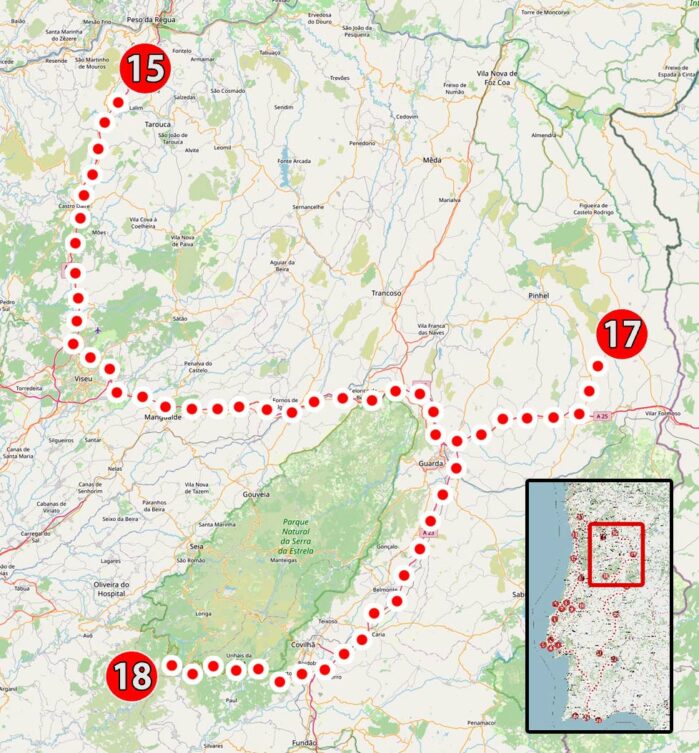
This day is the beginning of the journey to the south of Portugal along the eastern border of the country. We will return to the view of the sea in a few days. For now, we are going to take a trip around smaller towns and along much less frequented trails. For me, this part of the trip was extremely pleasant. I like having a lot of space around me and freedom while exploring. In this part of Portugal, you won't complain about excessive crowds.
Unfortunately, it will be a long and tiring route. The section between Almeida (17) and Piodao (18) is particularly difficult. As you approach Piodao (18), depending on your navigation, the road may become increasingly narrower, technically worse and more winding. On long sections it may be the width of one car, and passing another vehicle will require looking for special bays. This fragment must be overcome very slowly and carefully.
Piodao (18) is the most difficult to reach point in the entire Portugal tour plan and getting here requires a lot of determination. The stone village is hidden somewhere among the vast hills and gives the impression of the end of the world. Anyone who likes this type of atmosphere will be pleased.
If you do not plan to spend the night in Piodao (18), or due to the small number of accommodation places, you did not manage to find a free place and after visiting Piodao (18) you have to go further to your accommodation, consider giving up visiting the first town: Almeida ( 17). This way you will gain approximately 3 hours (transfer + sightseeing in Almeida) to get from Piodao (18) to your planned accommodation.
Transit route (version without Almeida): Lamego (15) – Piodao (18)
Ride length: 155 km
Driving time (without breaks and sightseeing time): 2 h
day 11 – Piodao (18), Monsanto (19), Marvao (20)
Transit route: Piodao (18), Monsanto (19), Marvao (20)
Ride length: 270 km
Driving time (without breaks and sightseeing time): 4 h 30 min
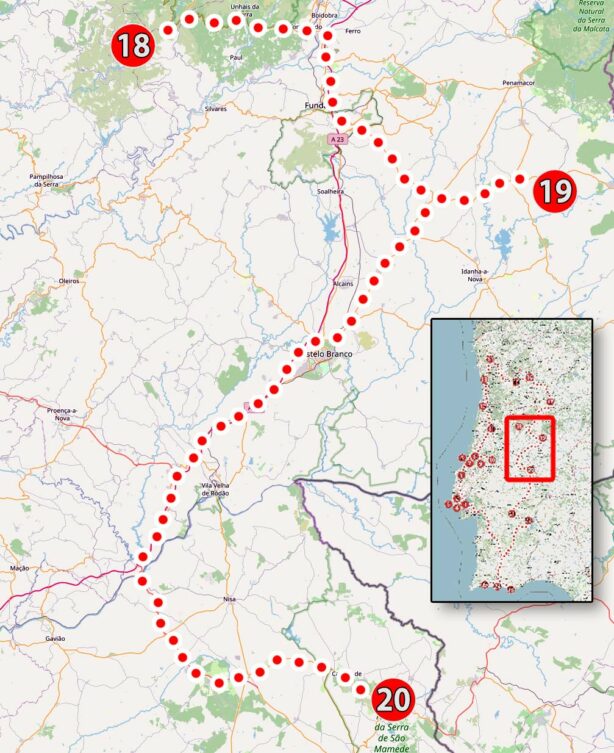
For the second day in a row, we will have a quite demanding ride, mainly due to the road from Piodao (18) to Monsanto (19). This part of the route is only a little over 100 km long but takes approximately 2 hours 30 minutes. However, Monsanto (19) is worth the effort, because it is definitely a unique place in the world. It's hard to find another such an unusual place.
At the end of the day we will reach the beautifully situated Marvao (20), where it is worth spending the night. In this part of Portugal, time passes completely differently and you will probably like this atmosphere. You will 100% want to stay here much longer than just one day.
day 12 – Elvas (21), Evora (22)
Transit route: Marvao (20), Elvas (21), Evora (22)
Ride length: 170 km
Driving time (without breaks and sightseeing time): 2 h 30 min
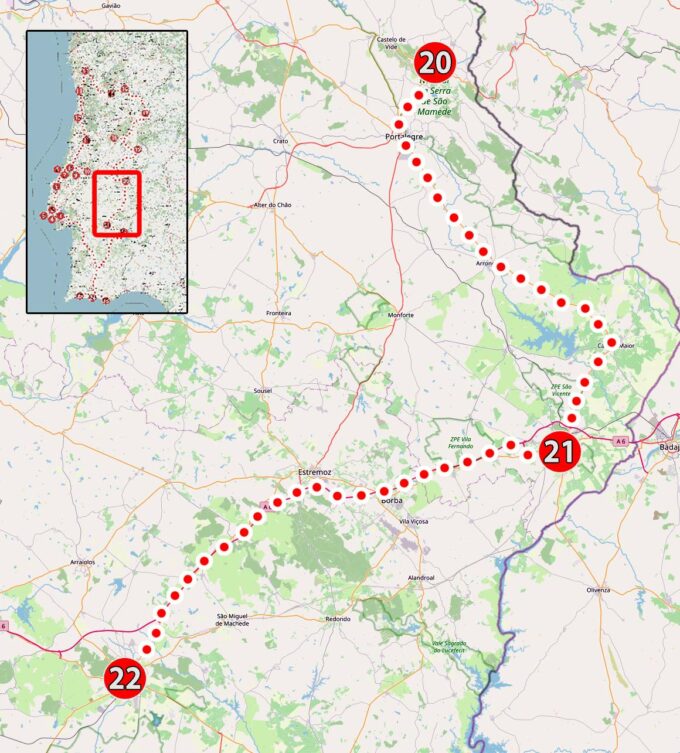
Today the road will take us to two more towns, both of which are on the UNESCO cultural heritage list. This is probably enough of a recommendation to see Elvas (21) and Evora (22). The route (fortunately for the driver) is definitely shorter and easier than on previous days. The most difficult part of the trip is already behind us, so there will be no major difficulties until the end of the trip.
WARNING!
On the road from Elvas to Evora you can stop and visit the castle located on a nearby hill, not far from the main road evoramonte.
Parking lot in front of the wall of Evoramonte Castle, GPS coordinates:
38°46’21.7″N 7°42’50.9″W
38.772698, -7.714134 - click and route
day 13 – Monsaraz (23), Faro (24)
Transit route: Evora (22), Monsaraz (23), Faro (24)
Ride length: 290 km
Driving time (without breaks and sightseeing time): 3 h 30 min
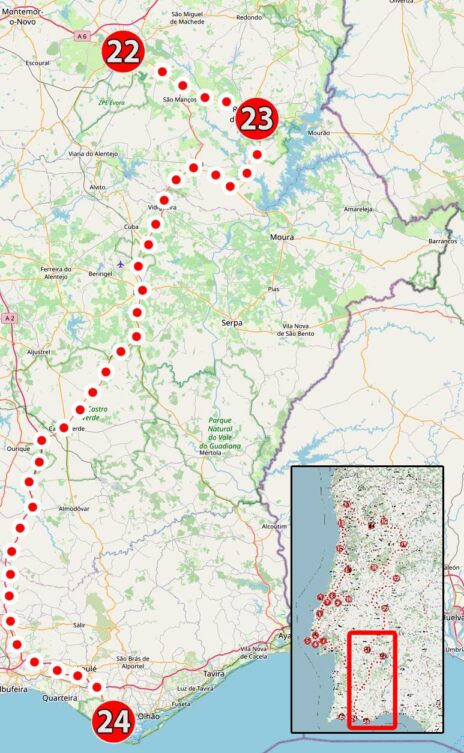
Today we will reach the southern tip of Portugal, the extremely picturesque Algarve coast. However, before we start enjoying the beautiful beaches along the way, one more stop in Monsaraz (23). The reward for the journey so far will be the sunset, which you will be able to spend that day with a cold drink by the sea in Faro (24). A pleasant prospect, isn't it?
day 14 – Benagil (25), Lagos (26)
Transit route: Faro (24), Benagil (25), Lagos (26)
Ride length: 100 km
Driving time (without breaks and sightseeing time): 1 h 30 min
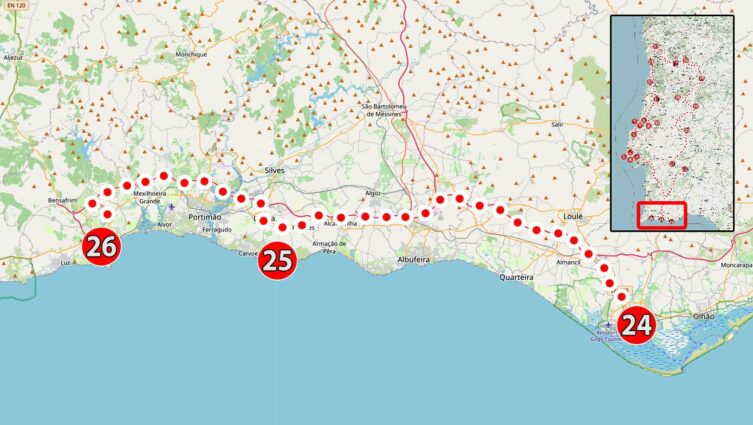
Today we will explore the Algarve coast and admire the wonders nature has created here. On the one hand, after such a long journey around Portugal, one would like to rest for a while in the sun and by the water, but on the other hand, the coast is so amazing that it would be a pity not to see some spectacular places. The choice is yours.
day 15 – return to Lisbon (1)
Transit route: Faro (24), Lisbon (1)
Ride length: 278 km
Driving time (without breaks and sightseeing time): 2 h 45 min
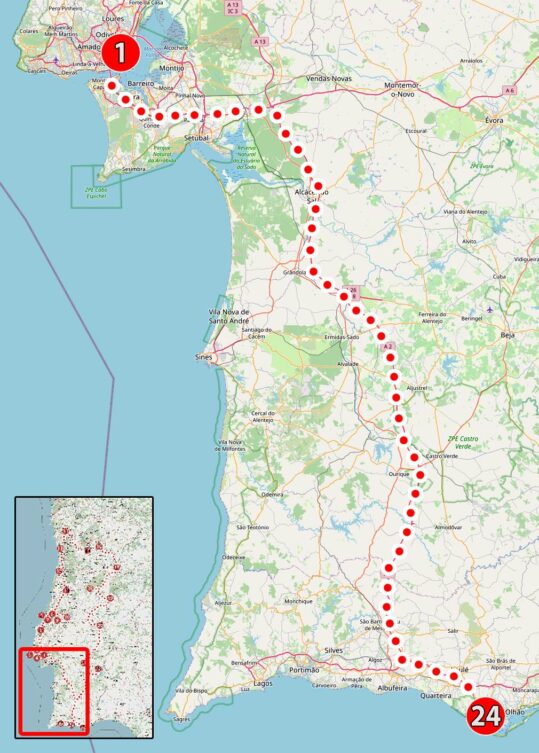
This is the last day of our trip. A purely technical journey awaits us, without any stops along the way. It will certainly be sad that this adventure is ending, but from my own experience I know that the photos and memories from this trip will quickly compensate for the sadness. Only beautiful memories and a smile on your face will remain, which is what I wish you!
Description of attractions on the trip route
1. Lisbon
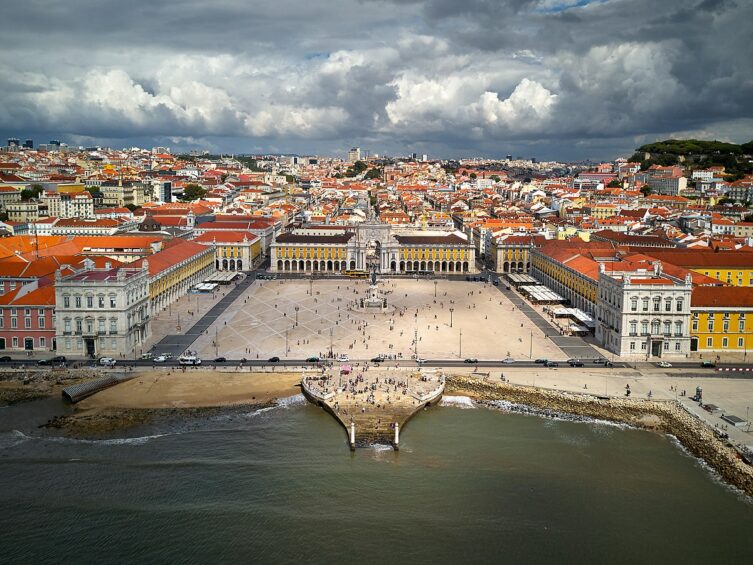
Visiting Lisbon is pure pleasure. The capital of Portugal deserves a separate entry and a separate plan. A well-thought-out sightseeing plan can be found in a separate entry: Lisbon – sightseeing plan [click]. Below I will include just some important practical information.
If you rent a car at the airport and drive to the center of Lisbon, I recommend going to the hotel first, leaving the car in the hotel parking lot, and exploring the city on foot or (if necessary) taking a short ride by public transport. If your hotel is located near the metro, it will be very helpful because one of its stations is exactly under the first point of the city tour plan (coincidence? :))
However, if you are going to spend the night outside Lisbon and need to leave your car somewhere in the center, you will find details of a large, underground city parking lot below. It's paid, but I suggest you use it anyway. In the center of Lisbon, every centimeter is worth its weight in gold, and most parking spaces are reserved for property owners and city residents. I don't advise messing with parking and trying to park somewhere by stretching the regulations. This can be a costly lesson. This rule applies to most popular places. Don't try to bend the rules.
check out: accommodation prices in Lisbon – [click]
Parking at the city square (Parque Praça do Município), GPS coordinates:
38°42’28.8″N 9°08’22.5″W
38.707996, -9.139574 - click and route
2. Sintra
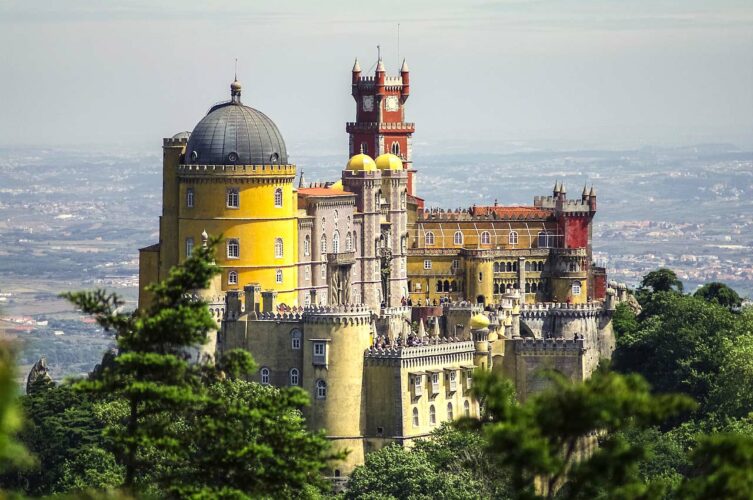
As I mentioned earlier (in the route description), it is best to start visiting Sintra as early as possible in the morning from the Pena Palace.
The palace opens at 9:00 am and at this time it is worth having already completed the journey and the search for a parking space. After that, it quickly gets crowded and cramped, and the situation is getting worse by the minute.
If you follow my advice, there is a good chance that you will take advantage of the possibility of free parking at "Estrada da Pena", the access road to the Castle of the Moors and the Pena Palace. The road is narrow and winds for approximately 3 km. On the section where it is painted at the edges of the road yellow line applies strictly No parking. You can only park in spaces marked with white lines and outside the solid white line.
Estrada da Pena is one-way, so if you don't find a parking space, the road will take you back to the city. Then you have two options: make another circle looking for a space or park in the city, near the stop tourist bus 434 and in approx 4 EUR per person take a bus to the palace. You have to make the decision on the spot, depending on the current situation.
Entrance tickets are a separate matter. It is definitely worth taking care of this in advance and purchasing them online. Then you can enter without queuing and avoid the hassle of waiting in line at the cash register. Unfortunately, tickets for the earliest entry times are sold first (everyone wants to avoid crowds). When I checked the availability at the time of writing this entry, the next 9:30 am entry tickets were available in over 2,5 months.
check out: entrance tickets to Pena Palace – [click]
Ticket packages seem to be an interesting option, and this one caught my attention Lisbon-Sintra Pass package – [click], which at the time of writing costs €49.
The package includes:
– Lisboa Card city card (i.e. access to 38 museums, including Torre de Belém and Mosteiro dos Jerónimos)
– unlimited free travel in Lisbon: bus, metro, tram (including tram 28) and elevators (including Santa Justa)
– free train travel to Sintra and Cascais
– entry to the Pena Palace in Sintra
– entry to the Moorish Castle in Sintra
– telephone audio guide to Sintra
– telephone audio guide around Lisbon
I think it is worth seriously considering this option of purchasing tickets.
Of course, people come to Sintra not only for the Pena Palace. Sintra is a huge area filled with interesting places and palaces. The rest of the places are a bit less difficult in terms of accessibility, so it will be easier than at the Pena Palace.
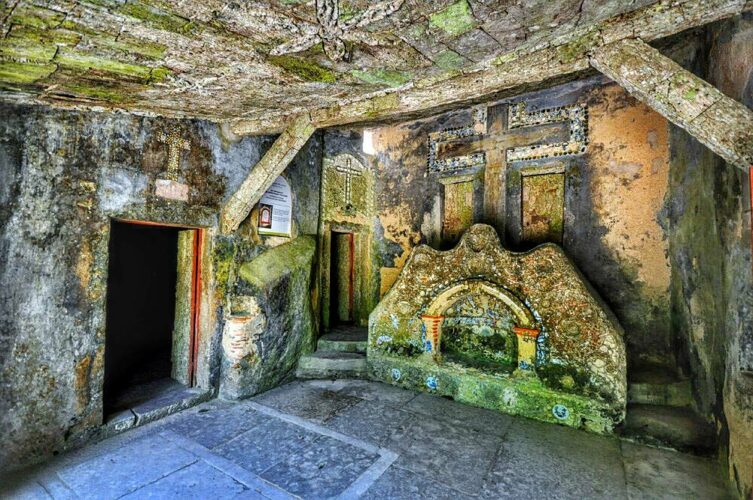
I will devote a separate, huge entry to visiting Sintra, but here I will only mention a few of the most important attractions that are worth seeing:
- Moorish Castle (Castelo dos Mouros) – check entrance tickets [click]
- Capuchin Monastery (Convento dos Capuchos)
– palace and park Vacation Specials - check entrance tickets [click]
- National Palace (Palácio Nacional de Sintra) – check entrance tickets [click]
- Monserrate Palace (Palácio de Monserrate) – check entrance tickets [click]
check out: accommodation prices in Sintra – [click]
Parking on the road near the Moorish Castle (Castelo dos Mouros), GPS coordinates:
38°47’24.2″N 9°23’22.0″W
38.790058, -9.389450 - click and route
Gate to Pena Palace (Palácio Nacional da Pena), GPS coordinates:
38°47’16.7″N 9°23’15.4″W
38.787959, -9.387623 - click and route
3. Cascais
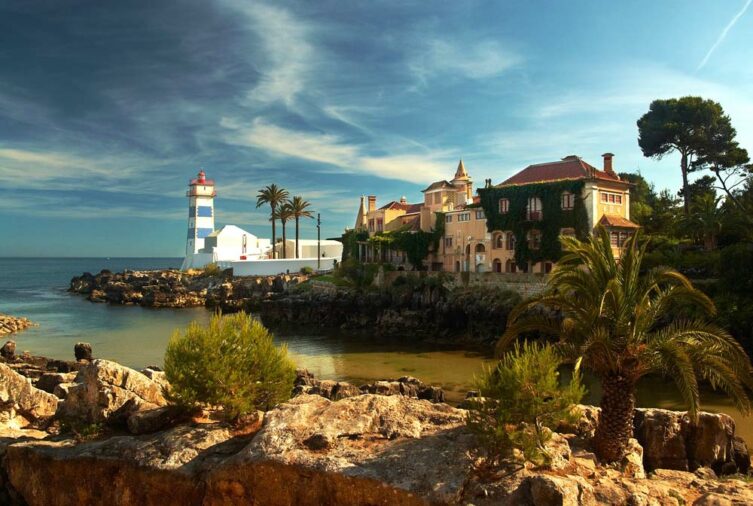
Cascais is a small but very pleasant seaside tourist town. Most attractions are concentrated around the town center and near the coast.
Cascais can be visited without the need for a detailed plan, even intuitively. The parking lot I chose, the coordinates of which I have provided below, is located literally between two city attractions: the Paula Rego House of History and the Marechal Carmona city park. Then just head towards the marina and then along the coast to Estoril. You will come across almost all attractions during this simple walk.
check out: accommodation prices in Cascais – [click]
Cascais - car park near the most interesting attractions, GPS coordinates:
38°41’39.0″N 9°25’26.3″W
38.694154, -9.423979 - click and route
Cascais - alternative parking, if there was no space on the first one, GPS coordinates:
38°41’35.7″N 9°25’33.5″W
38.693238, -9.425958 - click and route
3.1. Cabo da Roca
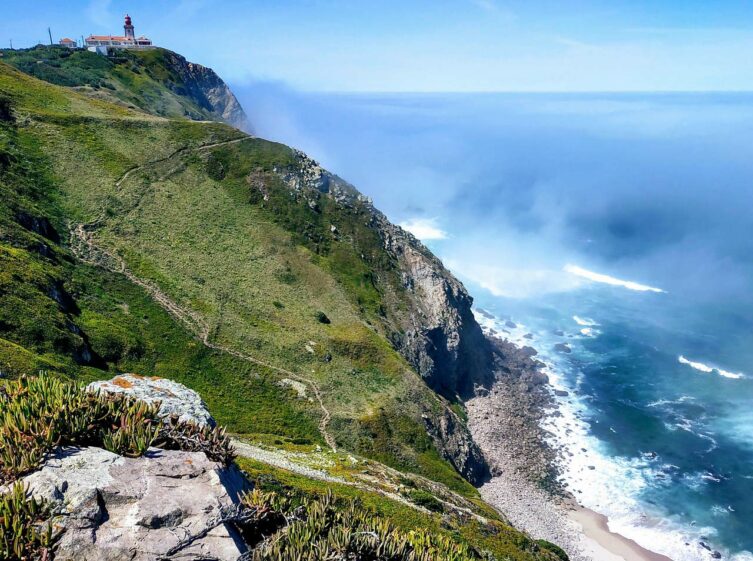
Cabo de Roca is the westernmost part of the European continent. You can't go further west on land in Europe. It may seem like nothing, but just knowing that you are standing on the most protruding piece of land, at the very end of the continent, is quite pleasant.
By the way, it is quite an interesting viewpoint. Cabo de Roca is worth visiting. If you're lucky, maybe you'll hit stormy waves :)
check out: accommodation prices near Cabo da Roca – [click]
Parking at the Cabo da Roca viewpoint, GPS coordinates:
38°46’50.1″N 9°29’52.0″W
38.780580, -9.497763 - click and route
3.2. Royal Palace of Queluz (port: Palácio Real de Queluz)
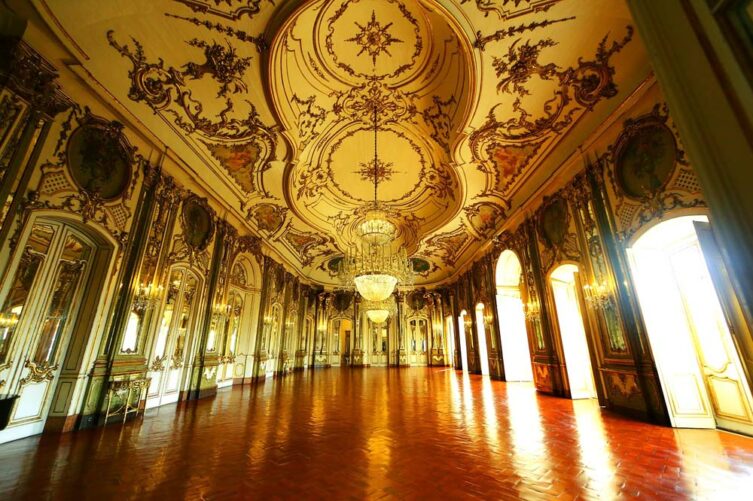
Sometimes called the "Portuguese Wedding", the palace in Queluz is one of the last such impressive Rococo buildings in Europe. It was supposed to serve as the royal summer residence, but history turned out to be the official royal residence for some time. So it's no surprise that the palace is truly amazing. The decorations, interiors and furnishings are of the highest royal standard. Exceptional beauty and wealth.
check out: accommodation prices in Queluz – [click]
Parking lot at the palace in Queluz, GPS coordinates:
38°45’02.4″N 9°15’28.6″W
38.750657, -9.257956 - click and route
4. Estoril
Estoril is a destination, but only as a coastal walk from Cascais. There is no point in driving your car only to Estoril, unless you want to walk along the coast, but in the other direction. So you start from Estoril and go to Cascais and back.
Please enter the coordinates for the end point of your walk below (as you walk from Cascais). At this point you need to turn around and return to your car in Cascais. There is also a small car park near this point.
check out: accommodation prices in Estoril – [click]
The turning point when walking from Cascais to Estoril, GPS coordinates:
38°42’05.3″N 9°23’26.7″W
38.701462, -9.390745 - click and route
5. Obidos
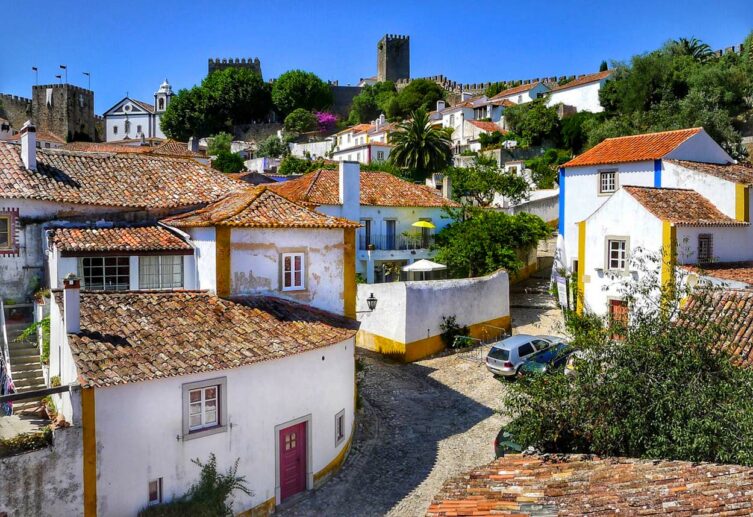
The medieval city of Obidos is located on the top of a hill and can be seen from a distance. A huge castle towers over the town, and all city buildings are tightly surrounded by a powerful defensive wall. Walking along the top of the defensive walls, you can walk around the entire city.
The internal buildings of Obidos are typical, narrow, medieval streets, tightly filled with small buildings, with characteristic whitewashed walls and countless colorful flowers.
In the summer, thematic festivals are often held in Obidos (chocolate festival, medieval market, etc.), during which additional attractions appear on the city streets (flags, banners, medieval art shows).
A local product from Obidos is thick cherry liqueur Ginja, sometimes served in a dish made of chocolate. I don't think I need to advertise this combination of flavors. I recommend!
check out: accommodation prices in Obidos – [click]
Obidos – large parking lot in front of the defensive walls, GPS coordinates:
39°21’32.0″N 9°09’23.5″W
39.358890, -9.156535 - click and route
if there is no space in this car park, then there is another large car park several dozen meters away.
6. Nazare
Nazare is known for the largest waves in the world, generated here by the Atlantic Ocean. Surfers from all over the world come here to try their hand at unprecedented waves. Unfortunately, in summer the waves never reach the same height as in winter. In winter, they can reach up to 30 meters (a typical 4-story building is approximately 15 meters). You can see a sample of the waves from Nazare in the video above.
By the way, Nazare is a popular and eagerly visited tourist town with nice beaches. Perfect for a few moments of rest during a long journey.
check out: accommodation prices in Nazare – [click]
Parking at the viewpoint from the cliff on Nazare, GPS coordinates:
39°36’18.3″N 9°04’42.7″W
39.605075, -9.078519 - click and route
Lighthouse with a viewpoint on the top of the cliff in Nazare, GPS coordinates:
39°36’16.5″N 9°05’04.7″W
39.604589, -9.084646 - click and route
7.Alcobaca
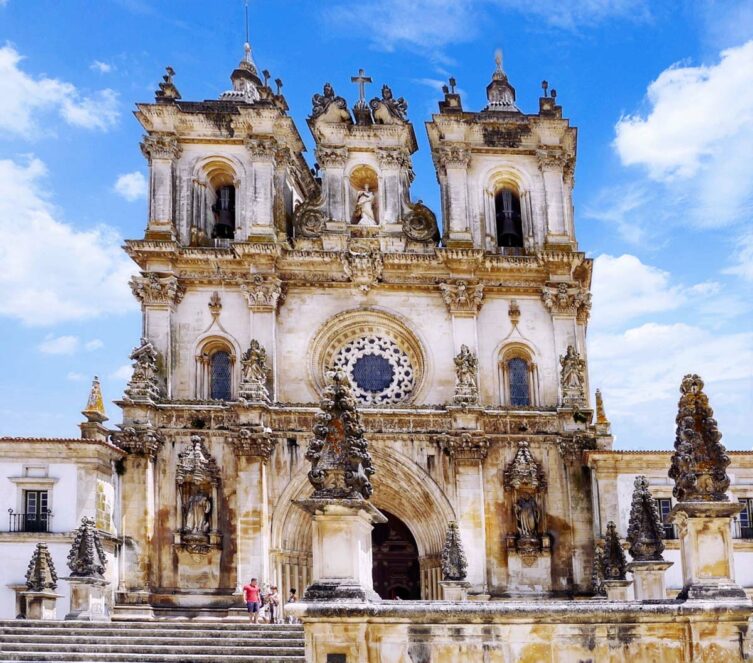
The two quiet and unremarkable rivers Alcoa and Baça meet here. The name of the town that grew up at the junction of the rivers is a natural combination of their names: Alcobaca.
Initially, Alcobaca was a small and not widely known town. It began to gain fame when King Afonso Henriques of Portugal decided that a church would be built here to commemorate the recapture of the city of Santarem from the Moors. Over time, the church was transformed into a monastery under the care of the Cistercian Order. This is how one of the most valuable monuments in Portugal was created: the Alcobaça Monastery (inscribed on the UNESCO list in 1989).
The Alcobaca Monastery is the main reason for coming to the town for most tourists, including us. There is an extremely dramatic story associated with it, the main character of which is King Peter I of Portugal and his lover Ines de Castro. Both are buried in the monastery, and their tombstones are considered masterpieces of sculptural art.
check: accommodation prices in Alcobaca – [click]
Parking near the Cistercian Abbey of Alcobaça, GPS coordinates:
39°32’56.9″N 8°58’31.2″W
39.549151, -8.975333 - click and route
Main entrance to the Cistercian Abbey of Alcobaça, GPS coordinates:
39°32’53.6″N 8°58’48.6″W
39.548219, -8.980158 - click and route
8. Battle
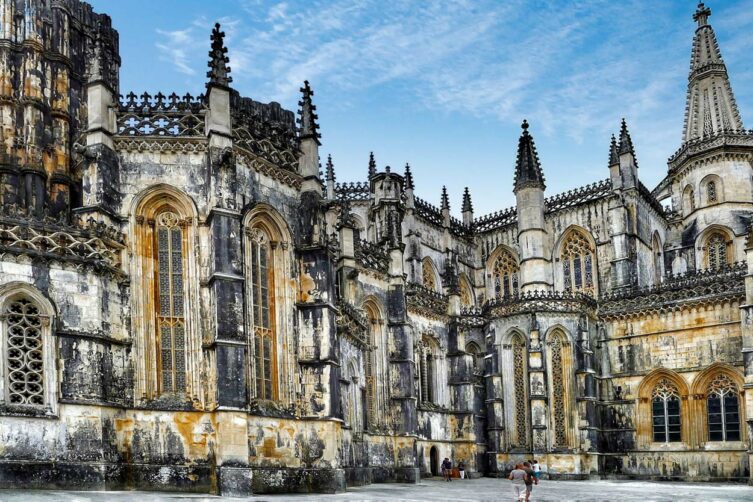
Batalha is another Portuguese town where we come to visit just one object.
Mosteiro de Santa Maria da Vitória, or the Monastery of Our Lady of Victories, is one of the most beautiful buildings I have ever seen. The size, scope, diversity, precision of workmanship... everything you can imagine. The monastery in Batalha is simply speechless. An amazing, delightful and unique facility that should not be missed.
The monastery consists of several parts, so allow yourself at least an hour, or better yet, two hours to visit them. You have to see:
– in the form of a monumental rotunda, Unfinished Chapels (Capelas Imperfeitas),
– Founder's Chapel (Capela do Fundador),
– Royal Cloister (Claustro Real),
– Chapter House, Old Refectory,
– Cloister of Alfonso V (Claustro D. Alfonso V)
- church
For the sake of formality, I will only add that the monastery is on the UNESCO list.
check out: accommodation prices in Batalha – [click]
Parking lot at the monastery in Bataha, GPS coordinates:
39°39’37.1″N 8°49’31.0″W
39.660301, -8.825278 - click and route
9. Fatima
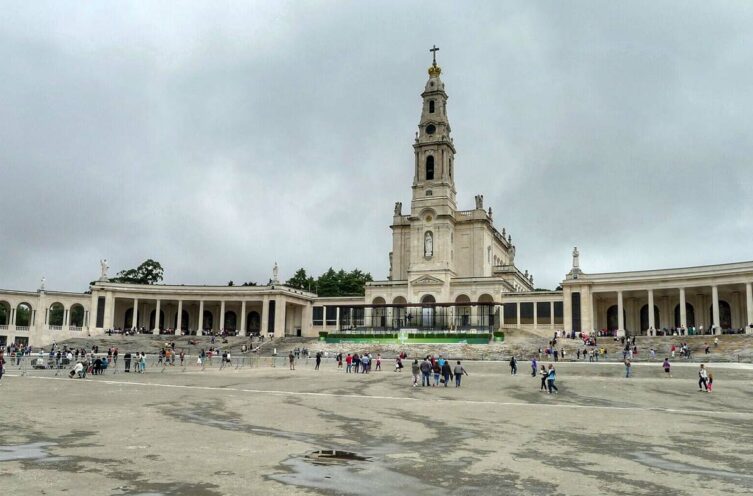
Fatima is, above all, a world-famous pilgrimage center and a center of Marian cult of the faithful of the Catholic Church. It was created and is directly related to Marian apparitions that are important for the church. The first one took place in 1758. Our Lady appeared to a mute shepherdess, restoring her voice. In gratitude for the healing, the girl's father built a chapel in the village.
Less than 200 years later, in 1917, a series of Fatima apparitions took place here, when Our Lady appeared several times to Francisco and Jacinta Marto and Lucia dos Santos, giving them the so-called Fatima secrets.
Apart from the religious aspect, the sanctuary in Fatima is not a building with unique architecture. So if the religious sphere is less important to you, this point is not obligatory.
check out: accommodation prices in Fatima – [click]
Several adjacent car parks at the sanctuary of Fatima, GPS coordinates:
39°37’39.5″N 8°40’45.7″W
39.627626, -8.679362 - click and route
10. Take
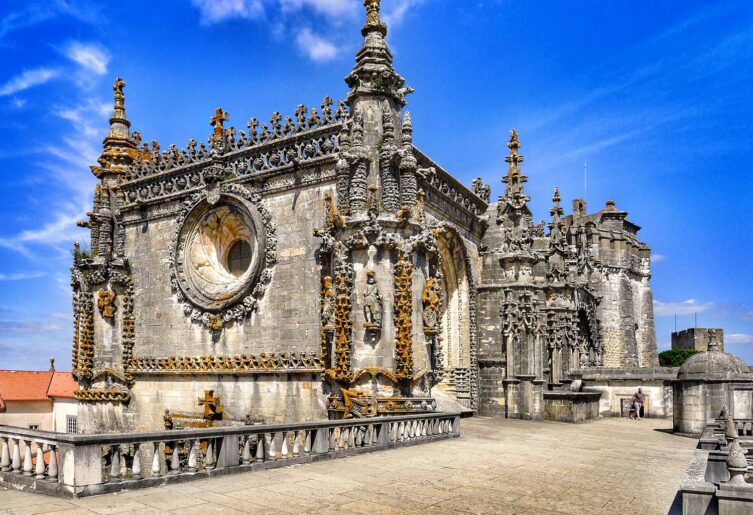
Tomar is another town whose visit is dominated by one object: Templar Monastery. However, before I write a few words about the monastery, I would like to strongly recommend visiting the market square in Tomar. It is really beautiful and surrounded by wonderful buildings (town hall, São João Baptista church with a historic bell tower, town houses).
The main attraction of Tomar, or the Convent of the Order of Christ (Convento de Cristo - on the UNESCO list), before it gained its current name, was the main headquarters of the Templars in Portugal. When the rapidly growing power of the Templar Order began to threaten the greatest rulers and countries in Europe (including King Philip VI of France the Beautiful, who incurred a huge debt with the Templars and was unable to pay it back), the king of France undertook a breakneck action, carried out in the highest secrecy. At dawn on October 13, 1307, he made an unexpected arrest of all significant figures of the order (several hundred of the most important monks in total). The monks locked in the dungeons were subjected to severe tortures in order to obtain confessions about the heresy existing in the order. With forced confessions at his disposal and using his influence in the Vatican, the French king persuaded Pope Clement V to dissolve the order. It is true that Clement V tried to conduct his own, independent trials and interrogations of the arrested monks, but he failed. Before he did it, King Philip IV of France managed to burn all the Templars at the stake. In 1314 the Templar Order ceased to exist (in March of that year in Paris the Grand Master of the Templars was burned at the stake Jacob de Molay).
Four years later (in 1318), thanks to King Dionysius, the order in Portugal returned to life under a new name: Order of the Knights of Christ, and the monastery in Tomar became their property. Almost until the end of the XNUMXth century, the Order of the Knights of Christ managed and intensively expanded the monastery, and one of its Grand Masters was Henry the Navigator himself, the discoverer of Madeira, the Azores and the Cape Verde Islands.
Today we can admire stunning architecture and amazing decorations here. After visiting several previous places, you may think that nothing will surprise you anymore. In Tomar you will find out that you were wrong. It will surprise and delight you.
Curiosity:
The day on which the King of France arrested the Teplars (October 13, 1307) was a Friday. This is where the unlucky superstition about "Friday the 13th" comes from.
The date "Friday 13" appears within each at least once, but a maximum of three times.
more information can be found in the special entry about visiting Tomar – [click]
check out: accommodation prices in Tomar – [click]
Underground parking right next to the market square, in the historic part of Tomar, GPS coordinates:
39°36’14.2″N 8°24’56.4″W
39.603948, -8.415675 - click and route
from this parking lot it is very close to the monastery of the Order of Christ, so you can walk there.
A small parking lot in front of the monastery of the Order of Christ, GPS coordinates:
39°36’14.3″N 8°25’02.2″W
39.603976, -8.417276 - click and route
11. Coimbra
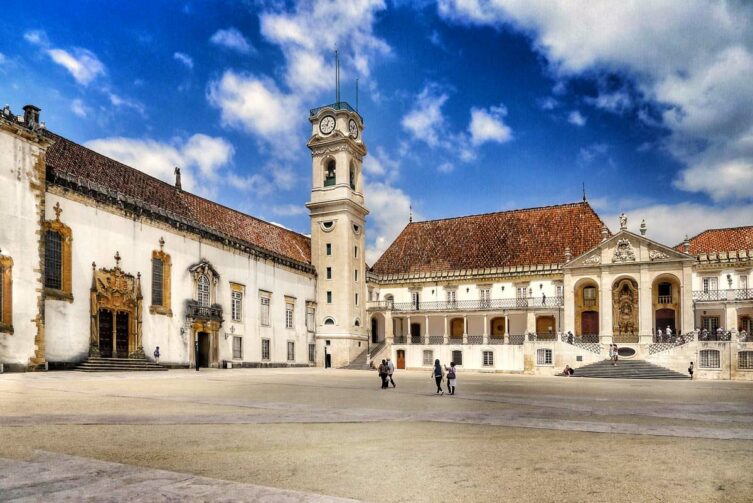
Coimbra is a unique place on the map of Portugal. The city was the first capital of the Kingdom of Portugal and the seat of the monarchs. Six kings of Portugal were born here, the first Portuguese royal dynasty comes from here and the oldest, most prestigious Portuguese university operates here: University of Coimbra.
It is worth spending at least half a day and one evening to explore the city. During the day we will visit the main monuments:
– university (Universidade de Coimbra)
– New Cathedral (Se Nova) from 1554
– Sao Salvador church
– church (formerly a cathedral, the oldest in Portugal) Se Velha
– Igreja de Santa Cruz church (from 1131) – the first two rulers of Portugal are buried inside: Alfonso I the Conqueror and Sancho I
– the monastery of Santa Clara-a-Nova (1649), with the tomb of the city's patron saint – Queen Isabella.
– ruins of the monastery of Santa Clara-a-velha
– Quinta das Lágrimas palace, currently transformed into a luxury hotel
It is worth spending the evening looking for street musicians who perform a specific genre of music from Coimbra: fado. Fado from Coimbra is sung only by men dressed in traditional student costumes, accompanied by a characteristic Portuguese guitar. Nowhere can you listen to fado as well as here.
Unfortunately, parking a car in Coimbra is always a challenge. There is always not enough space. Below are the coordinates of several convenient locations.
check out: accommodation prices in Coimbra – [click]
Underground paid public parking, GPS coordinates:
40°12’19.6″N 8°25’33.7″W
40.205447, -8.426031 - click and route
Parking near the historic center, next to the botanical garden, GPS coordinates:
40°12’13.3″N 8°25’32.9″W
40.203691, -8.425794 - click and route
Paid multi-story parking near the old town, GPS coordinates:
40°12’36.5″N 8°25’54.2″W
40.210142, -8.431720 - click and route
Last chance parking on the other side of the river at the Micro Museu de Santa Clara, opposite the historic center, GPS coordinates:
40°12’17.9″N 8°25’56.1″W
40.204981, -8.432252 - click and route
12.Aveiro
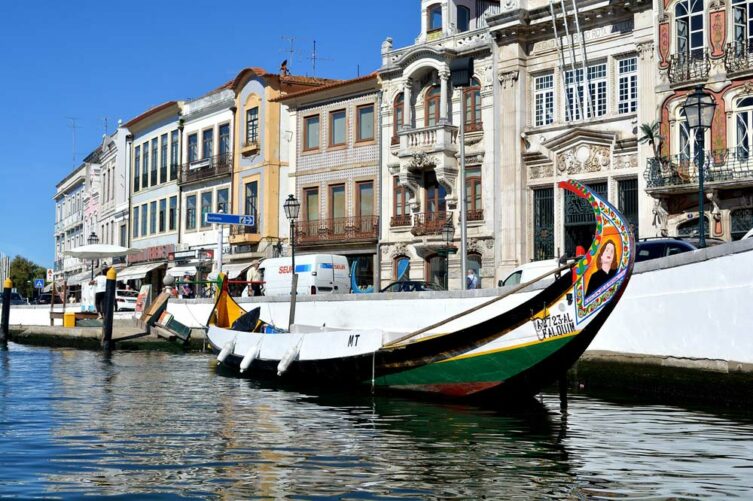
Pleasant to look at, the Aveiro undeniably has its own character. Due to the city's canals, on which picturesque boats sail (Moliceiro) is often called the Portuguese Venice. Indeed, it is a natural association that suggests itself, although Aveiro cannot be compared to Venice in size, beauty and the number of canals. So I advise you not to expect a Venice-like experience. Regardless of this, canals, boats, colorful houses on the waterfront and tenement houses along the streets create a pleasant atmosphere.
The best way to get to know the town is by sailing through the canals, and the cruise usually takes about one hour. Tickets for the Moliceiro cruise – [click] can be booked online.
check out: accommodation prices in Aveiro – [click]
While in Aveiro, it is worth visiting the famous... striped beach houses Costa Nova. A small, seaside tourist town adjacent to fantastic, extensive beaches. The fishing cottages, cobblestone streets, fish market and ocean breeze create a really cool atmosphere.
check: accommodation prices in Costa Nova – [click]
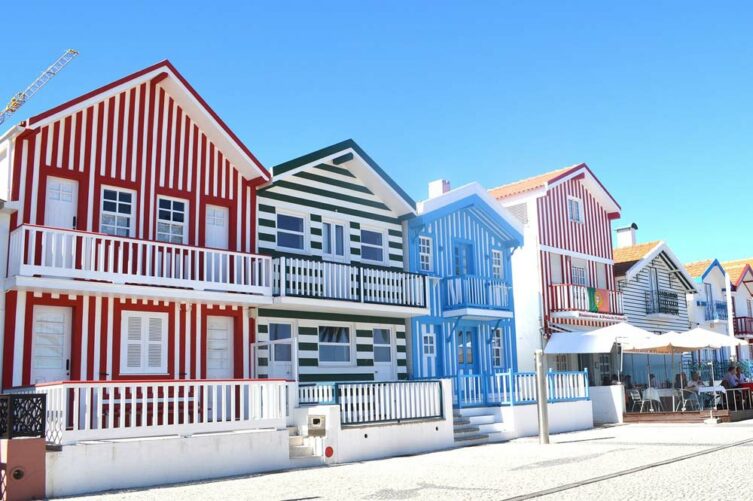
Parking in Aveiro next to the characteristic bridge and canals, GPS coordinates:
40°38’39.3″N 8°39’24.2″W
40.644250, -8.656722 - click and route
Parking lot next to the characteristic, striped houses in Costa Nova, GPS coordinates:
40°36’42.8″N 8°44’58.9″W
40.611884, -8.749702 - click and route
13. Port
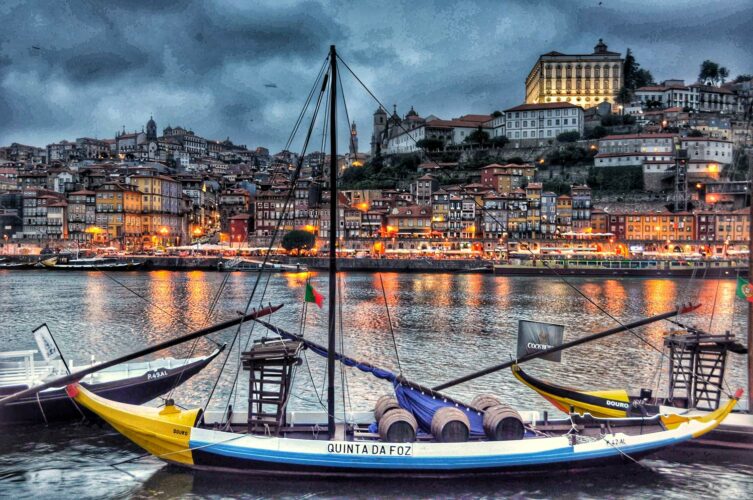
There is no need to encourage anyone to visit Porto. This old and beautiful city, situated on the waters of the Douro River, which flows into the ocean here, will surely absorb you for many hours. Walking around Porto can sometimes be demanding, because the city was built on a rather steep and uneven waterfront, but thanks to this, you will constantly come across fantastic views, panoramas, and viewpoints.
Porto will receive a separate guide from me (which is being slowly developed), so there will soon be a special link here. For now, however, I will only include the coordinates that will allow you to easily reach the parking lot near the city center so that you can quickly and efficiently explore it.
check out: accommodation prices in Porto – [click]
Entrance to the underground parking lot next to the historic center of Porto, GPS coordinates:
41°08’45.4″N 8°36’52.5″W
41.145934, -8.614583 - click and route
14. Panty
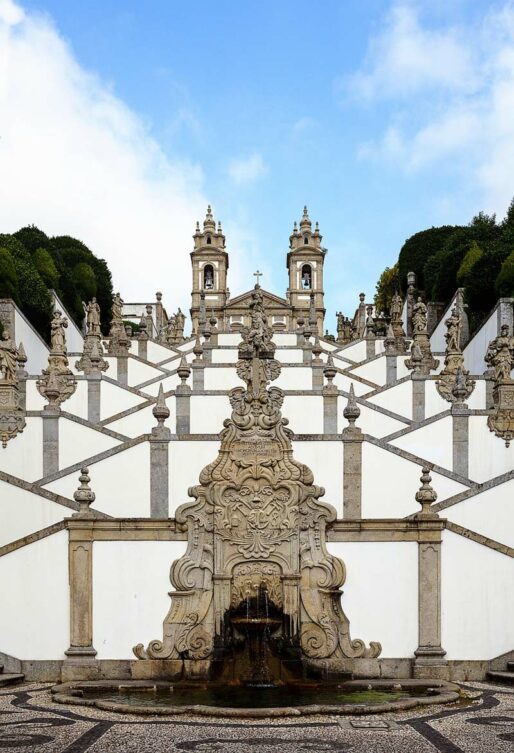
Braga has a special place among Portuguese cities. Not only because it is one of the oldest cities in Portugal, but also because it is home to the oldest Catholic archdiocese in the country. By the way, it is also one of the oldest Christian centers in the world. Tourists coming to Braga immediately notice the huge concentration of churches. Knowing that we are walking through one of the oldest Christian centers in the world makes such a density of temples no longer surprising. Statistics only confirm this. There is no city in Portugal with more churches per square meter.
Of course, there is no point in visiting all the churches. You can visit here and there, but the greatest pleasure comes from walking around the historic part of the city. There are also palaces, castles, gardens, park squares, arches and decorative gates that usually accompany sacred buildings.
A must-see is a visit to the UNESCO World Heritage Site, located approximately 7 km from the city center Bom Jesus sanctuary (full name: Bom Jesus do Monte). The top of the hill is occupied by a large basilica, but it is not the most important thing here. The most important are the stairs leading from the foot of the mountain to the basilica. Made in the Baroque-Rococo style, they are 115 meters high, have 577 steps and are divided into three parts:
– the first part starting behind the entrance gate to the sanctuary: Stairs of the Way of the Cross
– middle part: Stairway of the Five Senses
– upper part: Stairs of the Three Virtues
If climbing the 577 steps is too much of a challenge for you, you can use the world's oldest hydraulic cable car operating on the slope.
check out: accommodation prices in Braga – [click]
Underground parking near the historical center of Braga, GPS coordinates:
41°33’07.9″N 8°25’38.7″W
41.552201, -8.427408 - click and route
Parking at the sanctuary of Bom Jesus do Monte, GPS coordinates:
41°33’10.8″N 8°22’52.3″W
41.553010, -8.381196 - click and route
15. Lamego
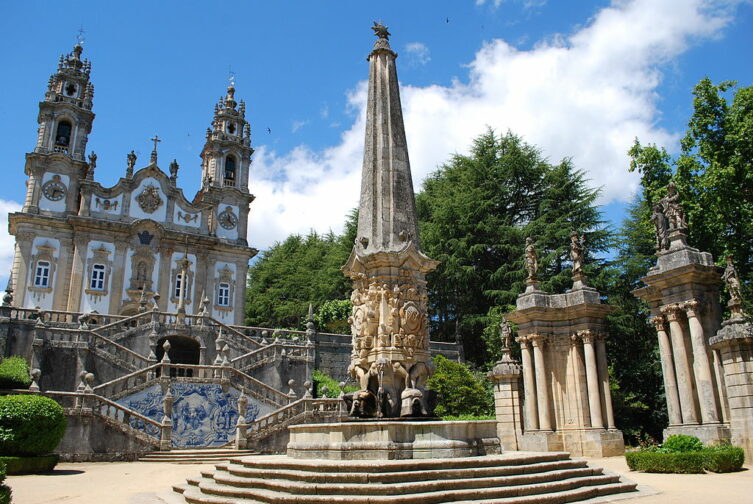
photo: Concierge.2C on terms CC BY-SA 3.0
Lamego is a small town beautifully situated among the hills surrounding the Douro Valley. The town center is not very large and sightseeing will not be too long or tiring. However, it must include a walk to the Nossa Senhora dos Remedios sanctuary located on a hill. The path is quite straight and, just like in the Bom Jesus sanctuary in Braga, it leads along stairs behind which there is a church. The stairs in Lamego are less known than in Braga, which does not mean that they are less charming. Moreover, from the stairs you can admire the amazing panorama of the city against the background of the surrounding hills. Fantastic view!
check out: accommodation prices in Lamego – [click]
Parking in Lamego near the stairs, GPS coordinates:
41°05’42.4″N 7°48’41.5″W
41.095115, -7.811538 - click and route
16. Douro Valley
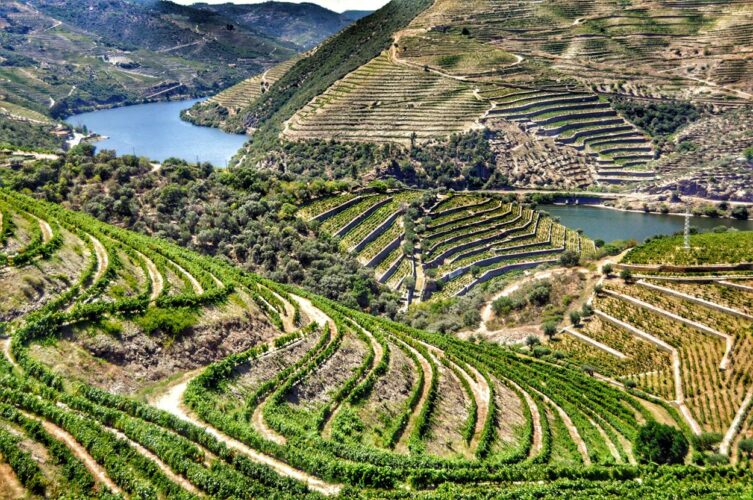
Exploring the valley involves freely traversing it in search of viewpoints, vineyards and discovering it in your own way. For your convenience, I have prepared a proposal for a ready-made route from viewpoint to viewpoint, which will help you plan your visit to the valley.
Below you will find a suggested route that runs between six viewpoints.
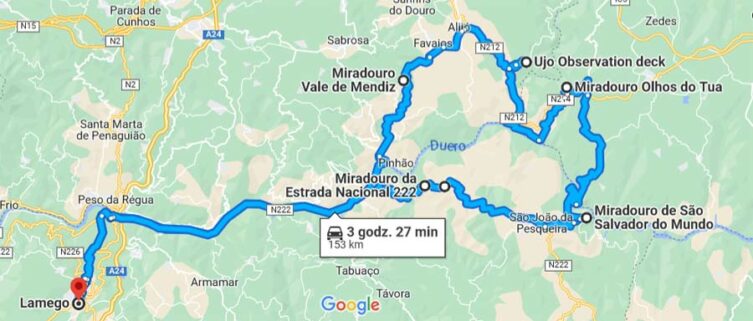
map base: Google Maps
As you can see on the map, the entire route is 153 km long, and the travel time (without stops and breaks) is about 3 hours 30 minutes. At first glance, the travel time for such a short route may seem exaggerated, but in practice it is not exaggerated. The roads here are very narrow and winding. In fact, most of the time you will be going uphill or downhill, and often these will be winding switchbacks.
The viewpoints I have provided are only a small fragment of what you will be able to see. There will be plenty of beautiful, unmarked places to stop along the way.
check out: accommodation prices in the Douro Valley Natural Park – [click]
Below are the GPS coordinates of all points. The order and number of points visited depends only on you. There is no obligation to complete the entire loop.
Miradouro da Estrada Nacional 222, GPS coordinates:
41°10’22.3″N 7°30’29.5″W
41.172853, -7.508198 - click and route
Miradouro de Frei Estevão ou da Abelheira, GPS coordinates:
41°10’21.1″N 7°29’25.1″W
41.172522, -7.490302 - click and route
Miradouro de São Salvador do Mundo, GPS coordinates:
41°09’04.5″N 7°21’56.5″W
41.151237, -7.365702 - click and route
Miradouro Olhos do Tua, GPS coordinates:
41°14’16.9″N 7°22’56.9″W
41.238028, -7.382484 - click and route
Miradouro to Ujo, GPS coordinates:
41°15’16.9″N 7°25’05.4″W
41.254697, -7.418158 - click and route
Miradouro Vale de Mendiz, GPS coordinates:
41°14’35.2″N 7°31’35.3″W
41.243106, -7.526482 - click and route
17. Almeida
Almeida is a typical fortress city. The size, design and shape of the city was completely subordinated to defensive and military functions. The small, tight, oval city center is entirely surrounded by huge military buildings in the shape of a star-shaped fort.
In the Almeida area, inside the city walls, there is one small parking lot and a few parking spaces from time to time on the road leading along the walls inside the town. Traffic is sometimes limited, so there is no guarantee that you will be able to get inside the walls. If such a situation arises, simply look for a place near one of the city's entrance gates.
check out: accommodation prices in Almeida – [click]
Small parking lot inside the city, GPS coordinates:
40°43’26.7″N 6°54’24.7″W
40.724086, -6.906869 - click and route
Parking lot at one of the entrance gates to the city (Porta de Sao Francisco), GPS coordinates:
40°43’22.0″N 6°54’18.0″W
40.722789, -6.905009 - click and route
A tiny parking lot at the Porta de Santo Antonio gate, GPS coordinates:
40°43’33.4″N 6°54’38.1″W
40.725947, -6.910588 - click and route
More on-street parking, outside the city walls, GPS coordinates:
40°43’41.1″N 6°54’02.6″W
40.728094, -6.900713 - click and route
18. Piodao
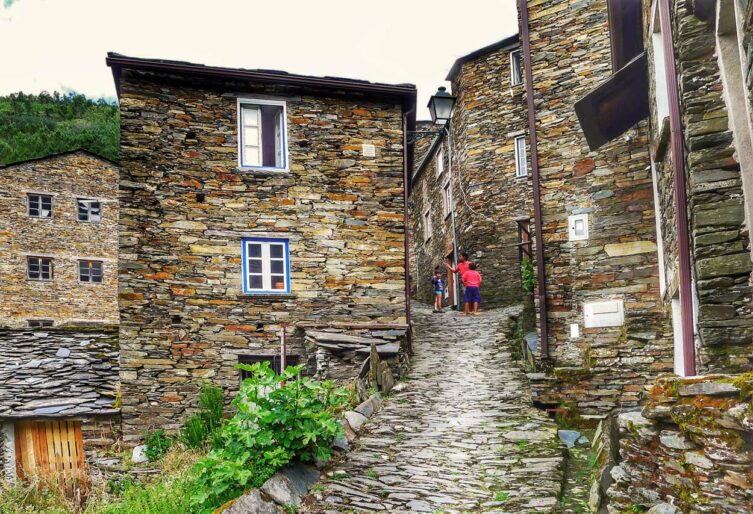
Getting to Piodao is a real journey. This will definitely be the most difficult part of the trip for the driver. Piodao is a small, beautifully situated village, located in the Serra de Acor mountain range. It hangs almost unnaturally, glued to the slopes of one of the mountain hills. Until the 70s, there was no road here that could be traversed by a motor vehicle. The only option was to walk on foot or ride a horse. To this day, Piodao remains one of the most isolated places in Portugal. The beautiful mountain scenery consisting of strongly undulating, green hills, partly converted into cascading and terraced arable fields, densely intersected by babbling streams and rivers, perfectly matches the character of the village. Everything in the village is made of natural stone slate, i.e. flat, brown stones. Houses, roads, walls, walls, roofs of houses... literally everything! In addition, the remaining elements of the houses have retained their traditional character, such as the shapes and colors of windows and doors and other elements of small architecture that give the village its visual character.
For some time, driving to Piodao, I had doubts whether it would be worth the enormous effort it took to get here. Once there, my doubts disappeared in a split second.
For more information, see separate entry about Piodao – [click]
check out: accommodation prices in Piodao – [click]
Parking on the road that is the entry and exit loop from Piodao, GPS coordinates:
40°13’43.4″N 7°49’31.7″W
40.228711, -7.825459 - click and route
Several parking spaces can also be found in the small square at the end of the entrance loop, GPS coordinates:
40°13’45.3″N 7°49’30.2″W
40.229247, -7.825059 - click and route
19 Monsanto
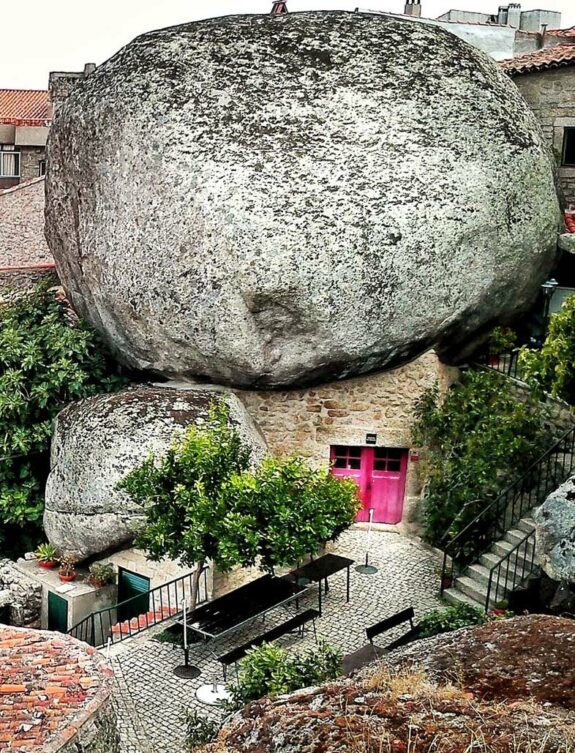
Monsanto is another Portuguese oddity. The town is a perfect example of what crazy ideas a person can come up with. Some of the houses in Monsanto were fitted between giant stones, often larger than the house itself. As if that wasn't enough, some people decided to live directly under the huge stones that serve as roofs in their houses. Everything looks really amazing, but I don't know if I could sleep well with a giant stone hanging over my head, which probably weighs several dozen tons.
Fantastic place, amazing experience! A must-see!
A detailed description of Monsanto, a sightseeing plan and a map of the town can be found in a separate entry: Monsanto – sightseeing plan – [click]
check out: accommodation prices in Monsanto – [click]
Parking in Monsanto, GPS coordinates:
40°02’23.7″N 7°06’51.0″W
40.039924, -7.114158 - click and route
20. Marvao
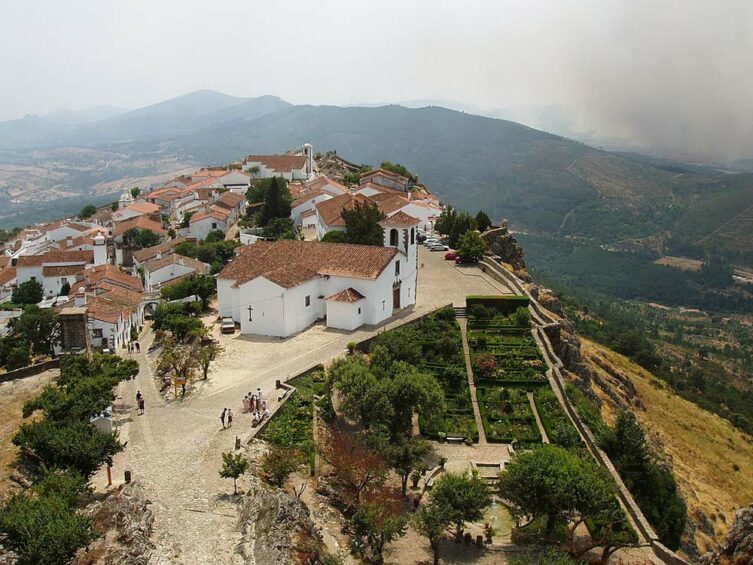
photo: Krzysztof Żwirski on principles CC BY-SA 3.0
Situated on a hill, with a brilliant panoramic view of the surrounding area and the runes of the mighty Marvao castle, it seems to be an ideal location for a tourist who likes beautiful and unique places at the same time. If you also want a bit of peace and quiet, without any crowds (most of the time you probably won't meet anyone), to be able to immerse yourself in a walk through narrow, undulating, medieval streets among small, whitewashed houses, then be sure to head to Marvao. I am sure that even if you never come back to this place in person, you will always think about it. Ah…Marvao!
check out: accommodation prices in Marvao – [click]
Tourist parking lot in front of the city gate to Marvao, GPS coordinates:
39°23’44.7″N 7°22’36.9″W
39.395747, -7.376912 - click and route
21.Elvas
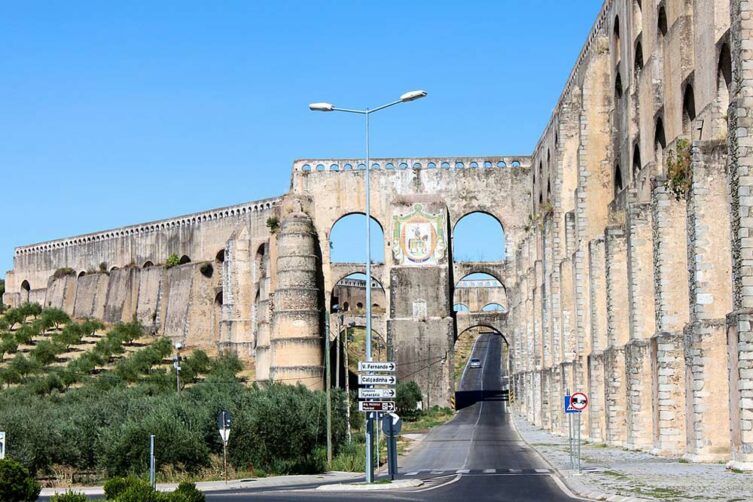
photo: Nmmacedo on principles CC BY-SA 3.0
There's really a lot to do in Elvas. At first glance, an inconspicuous small town in the provinces of Portugal, when you get to know it better, it offers a lot of extremely interesting attractions. Your main sightseeing points should be:
– a huge, approximately 6 km long aqueduct visible from afar (Aqueduto de Amoreira)
– Nossa Senhora da Graca fort, located about a kilometer from the city, inscribed on the UNESCO list
– historic center and market square in Elvas
– medieval castle of Elvas
– another of several forts located outside the city: Fort Santa Luzia
check out: accommodation prices in Elvas – [click]
Of course, below are the coordinates of nearby parking lots. You don't have to walk everywhere (you may run out of time).
Parking lot at Fort Nossa Senhora da Graca (UNESCO), GPS coordinates:
38°53’34.5″N 7°09’52.7″W
38.892928, -7.164649 - click and route
A place for a short photo stop under the aqueduct, GPS coordinates:
38°52’40.4″N 7°10’18.8″W
38.877897, -7.171900 - click and route
Parking near the walls of the historic city center in Elvas, GPS coordinates:
38°52’41.0″N 7°09’58.9″W
38.878060, -7.166361 - click and route
Parking lot at Fort Santa Luzia, GPS coordinates:
38°52’25.2″N 7°09’31.4″W
38.873662, -7.158729 - click and route
22. Evora
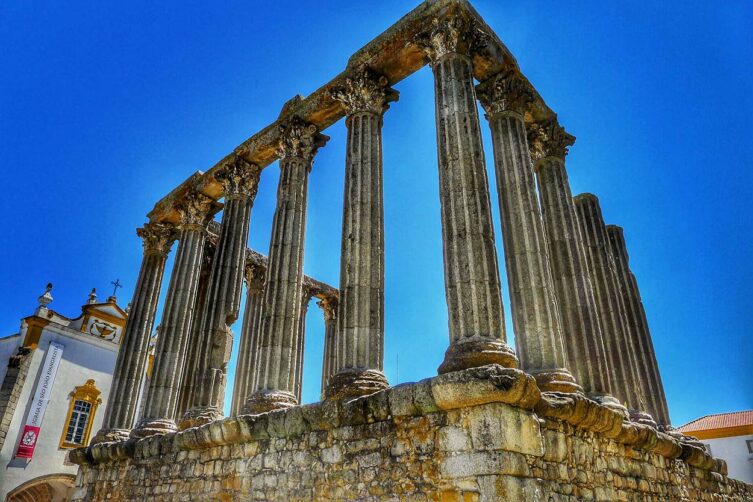
During this trip, we have probably become accustomed to the fact that Portugal constantly surprises travelers with extremely interesting and interesting monuments. Evora is no exception. Most visitors to the city direct their steps mainly to the Roman temple of Diana. Dating back to the 1870nd century AD, the building is the best-preserved ancient temple in Portugal. Its condition is mainly due to the fact that it was needed and used almost all the time, so it did not suffer from degradation like most other monuments whose existence was indifferent to people. The Temple of Diana has therefore played various roles in its history. In the Middle Ages, the Holy Inquisition eagerly used it as a place of execution. Later it housed an arsenal, which did not prevent it from being later transformed into a theater. Over time, it turned out that instead of a theater, a slaughterhouse would be a perfect place, and it operated until XNUMX.
Nowadays, fortunately, the building has returned to its original function, but only as a historical object and, together with the historical center of the city, it was included on the UNESCO list in 1986.
During a typical walk around the city, I suggest visiting the church adjacent to St. Francis (Igreja de São Francisco) of the so-called "chapel of bones" (Capela dos Ossos), When entering the chapel, pay attention to the welcome inscription: "Nós osso que aqui estamos, pelos vossos esperamos", which in translation means: Our bones that rest here are waiting for your bones.
And inside? What's inside? The entire interior of the chapel (walls and columns) is lined with the bones of over 5 monks, whose remains were collected in this way because the surrounding land was too valuable to be used for burying the dead.
There are also several megalithic objects near Evora, but I will write more about them in a separate, broader entry about Evora.
check out: accommodation prices in Evora – [click]
Parking on the street near the bone chapel, GPS coordinates:
38°34’08.9″N 7°54’32.9″W
38.569135, -7.909146 - click and route
Large parking lot near the historic part of the city, GPS coordinates:
38°34’30.6″N 7°54’17.6″W
38.575157, -7.904880 - click and route
23. Monsaraz
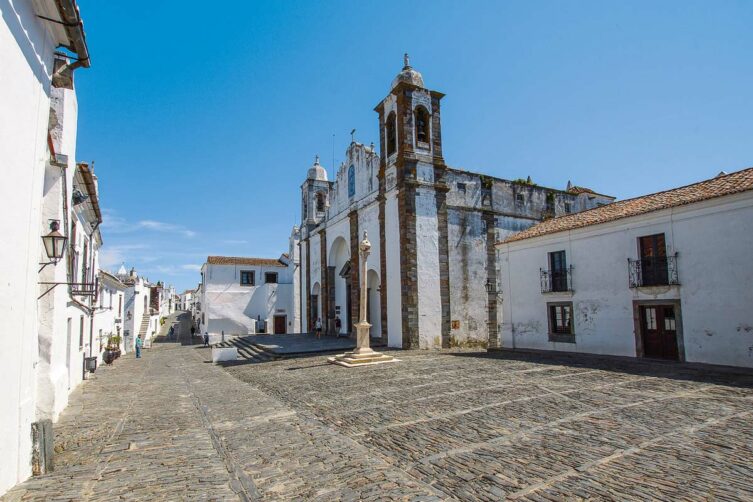
If you haven't had enough of cozy, quiet and beautifully situated towns, here's another opportunity to experience them. Monsaraz is the last stop before the incredibly beautiful but probably very crowded Algarve coast. This is the last moment to admire the fantastic Portuguese province, smelling of olives, wine and flowers. Monsaraz is one of those places where you would like to stay longer, and the views of the Guadiana river floodplain do not help you decide to leave this place and move on.
This time I will not go into detail about the sightseeing. I will only leave below the coordinates of the tourist parking lot at the city gate.
After such a trip, you are already an expert in visiting small Portuguese towns. Just do what you already know how to do: enjoy exploring Monsaraz on your own.
check out: accommodation prices in Monsaraz – [click]
Parking at the entrance gate to Monsaraz, GPS coordinates:
38°26’33.9″N 7°22’48.8″W
38.442762, -7.380228 - click and route
24. Faro
Finally, we reach the legendary southern coast of Portugal, Faro, which is the capital of the region. Paradoxically, we visit Faro almost at the end of our trip, but most often it is the first town that most visitors visit in Portugal. The main airport of the region is located in Faro. Every year, countless tourists arrive here by plane, eager for sun, warmth and exceptionally beautiful beaches where they can enjoy these benefits as much as they want. Then the first place you discover is Faoro. As luck would have it, it's a very pleasant, really nice and interesting city. A great incentive to further explore Portugal. For you, after two weeks of exploring Portugal's greatest attractions, Faro may not bring anything new... except one thing: the proximity of the wonderful sea and stunning coastline. So I expect you will spend relatively less time exploring Faro. We will spend most of our time exploring the coast and enjoying the charms of the southern rocky and sandy beaches of the Algarve.
check out: accommodation prices in Faro – [click]
Huge parking lot near the historic center and yacht marina in Faro, GPS coordinates:
37°00’44.2″N 7°55’54.6″W
37.012282, -7.931842 - click and route
25. Benagil Cave
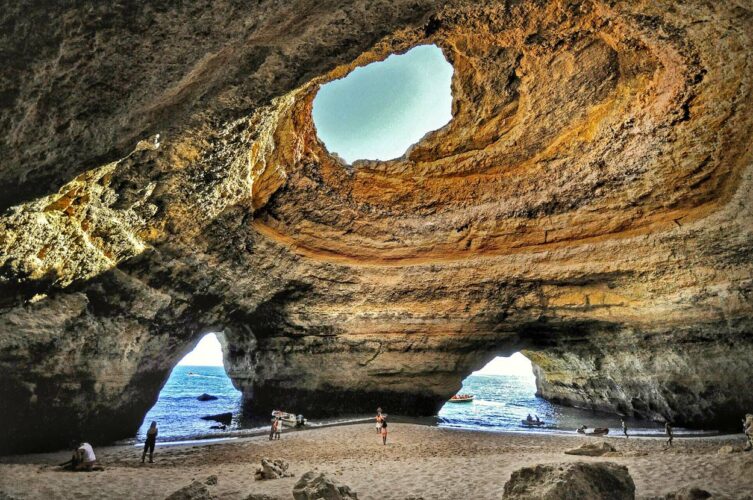
What is the name of the most beautiful cave in the world? It is certain that many people asked about this will immediately answer: Benagil Cave! It will be hard to disagree with this. Benagil will make a stunning impression even on those who think they have seen it all.
The miracle of nature that we can admire in this shape has been created for many centuries. The constant work of water, air, sun and wind first led to the creation of a deep cave, the ceiling of which partially collapsed over time. Sunlight streamed in through a hole in the ceiling, illuminating the interior. This fact allows us to admire the beauty of its interior in strong daylight and easily see every detail, color and texture of the rocks. This makes Benagil memorable.
Unfortunately, it can only be reached from the sea, and the tourist traffic has become so large that access is partially limited. A detailed guide on how to get to and visit the cave can be found in a separate entry: Benagil Cave – sightseeing – [click]
check out: accommodation prices near the Benagil cave – [click]
On street parking near Benagil Beach, GPS coordinates:
37°05’16.9″N 8°25’36.5″W
37.088022, -8.426808 - click and route
26. Lakes
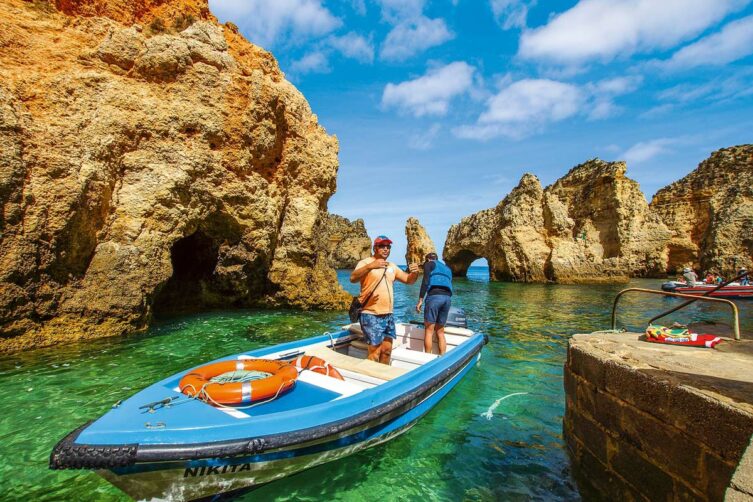
The fortune and curse of Lagos are its nearby beaches and coastline. We all know these beaches by sight, because postcards, souvenirs and advertising catalogs of travel agencies are full of their photos. The fanciful shore with yellow-orange rocks in shapes that even the most developed imagination could not imagine, bathed in the blue sky, azure waters of the sea and illuminated by the golden midday sun, marginalizes a truly beautiful and interesting city. The beaches are definitely the winner and Lagos is unfairly losing tourist attention.
I know time is short, but Lagos deserves more attention. And the beaches? The beaches are insanely beautiful, incredibly immersive and worth every moment spent on them.
Visiting Lagos means devoting enough time to the city so that you don't run out of time on the beaches. So sit back and plan this time as you see fit. Enjoy your last day in Portugal. Tomorrow begins the homecoming. You will remember these holidays for years. I guarantee!
check out: accommodation prices in Lagos – [click]
Below are the GPS coordinates of a parking lot in Lagos, at a viewpoint outside the city with a fantastic view of the coast and several beaches.
Underground parking in the coastal historic part of Lagos, GPS coordinates:
37°06’08.5″N 8°40’18.1″W
37.102367, -8.671698 - click and route
Estudantes Beach (beach with a rock tunnel to the next beach - be sure to go there), stairs lead from the parking lot to the beach, GPS coordinates:
37°05’49.4″N 8°40’06.6″W
37.097052, -8.668490 - click and route
Praia Dona Ana (beach), GPS coordinates:
37°05’28.9″N 8°40’12.4″W
37.091348, -8.670102 - click and route
Praia do Camilo (beach), GPS coordinates:
37°05’12.1″N 8°40’08.3″W
37.086692, -8.668962 - click and route
Praia da Luz (beach), GPS coordinates;
37°05’15.6″N 8°43’35.8″W
37.087655, -8.726618 - click and route
Meia Praia (huge, extensive, flat recreational beach), GPS coordinates:
37°06’46.2″N 8°39’30.4″W
37.112821, -8.658448 - click and route
Viewpoint on Cape Ponta da Piedade, GPS coordinates:
37°04’53.9″N 8°40’10.6″W
37.081641, -8.669604 - click and route
From the end of Cape Ponta da Piedade, take a walk along the coast. The views are truly crazy!
Important to me!
Give the article a good rating (5 stars welcome 😀)!It's free, a for me it is very important! The blog lives on visits and thus has a chance to develop. Please do it and ... thank you in advance!
If you like my guides, you will certainly find the one I created useful guide catalog - [click]. There you will find ready-made ideas for your next trips, descriptions of other tourist destinations and an alphabetical list of guides divided into countries, cities, islands and geographical regions.
I also post link to Facebook profile - [click]. Come in and press "Follow"then you will not miss new, inspiring posts.
Unless you prefer Instagram. I'm not a social media demon, but you can always count on something nice to look at on my instagram profile - [click]. The profile will gladly accept any follower who likes it.
I make the content I create available free of charge with copyright, and the blog survives from advertising and affiliate cooperation. So, automatic ads will be displayed in the content of the articles, and some links are affiliate links. This has no effect on the final price of the service or product, but I may earn a commission for displaying ads or following certain links. I only recommend services and products that I find good and helpful. Since the beginning of the blog's existence, I have not published any sponsored article.
Some of the readers who found the information here very helpful, sometimes ask me how you can support the blog? I do not run fundraisers or support programs (type: patronite, zrzutka or "buy coffee"). The best way is to use links. It costs you nothing, and support for the blog is self-generating.
Pozdrawiam

While searching for the desired information on the Internet, I found this article. Many people think they have adequate knowledge on this topic, but this is often not the case. Hence my positive surprise. I'm impressed. I will definitely recommend this place and visit here more often to see new posts.
There is no longer an option to rent without a deposit in the search engine. Everything with a deposit 🙁
It changes from time to time. You have to go back and check.
REVELATION!!!! This is exactly what I need to explore on my own. Specific and to the point. You are better than two guides put together (I will mercifully leave out which ones). I'm in the process of preparing for a two-week trip around Portugal and I'm grateful that someone did it for me and for me 😉 so much hard work 😀 THANK YOU so much!!!!!!
Perfectly prepared. Nothing more nothing less.
Pozdrawiam
Super prepared. I think I'll try :)
We are going to Portugal for the second time and for the second time we are gaining knowledge from this blog. Is great!!!! The first time in 2023 was Lisbon and the south from Benagil, now it will be the north (from Lisbon), the eastern part of Portugal and, of course, Faro and the surrounding area. We planned it for 2 weeks by car, of course. We start from the capital on April 24. Thank you very much for the great guide!!!
Fantastic description. I wrote them down and I will definitely use them when visiting Portugal.